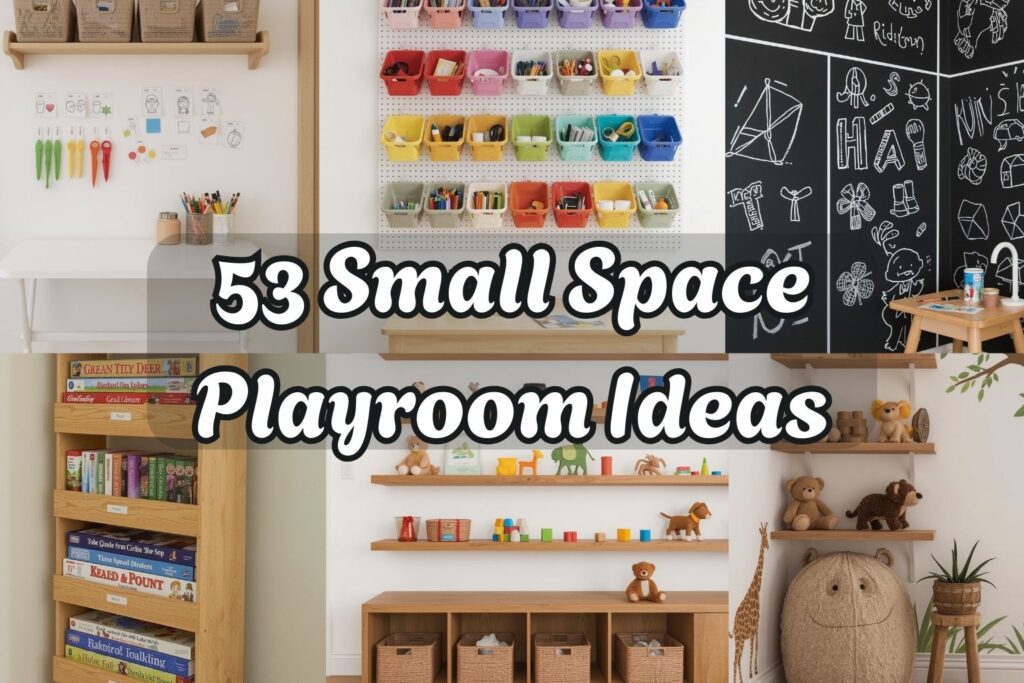Designing a playroom in a small home can feel challenging, but it’s also an opportunity to get creative. The secret lies in making every inch count while keeping the room fun, safe, and inviting. That’s exactly why we’ve put together 53 Small Space Playroom Ideas, to inspire you with clever solutions that maximize space without sacrificing joy. From cozy reading nooks to foldable furniture and imaginative wall features, these ideas will help you turn even the tiniest corner into a magical world for your kids. Whether you live in an apartment, a compact house, or just want to dedicate a small section of a larger room, these tips will show you how to blend functionality with playfulness. Get ready to reimagine your space and create a playroom your children will love.
Creative and Space-Saving Playroom Inspirations
1. Corner Reading Nook with Cushions
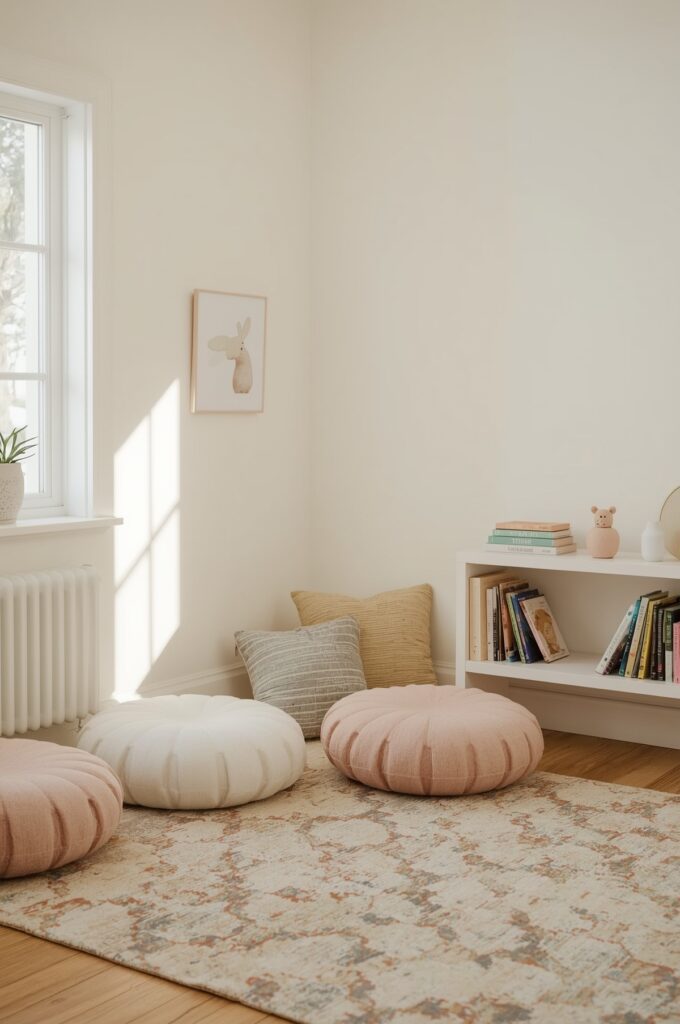
Create a cozy corner with soft cushions and pillows. Add a small rug to define the space and keep it inviting. Kids can enjoy reading, relaxing, or daydreaming in their little spot. This setup saves floor space while offering comfort and charm.
2. Floating Wall Shelves for Toys
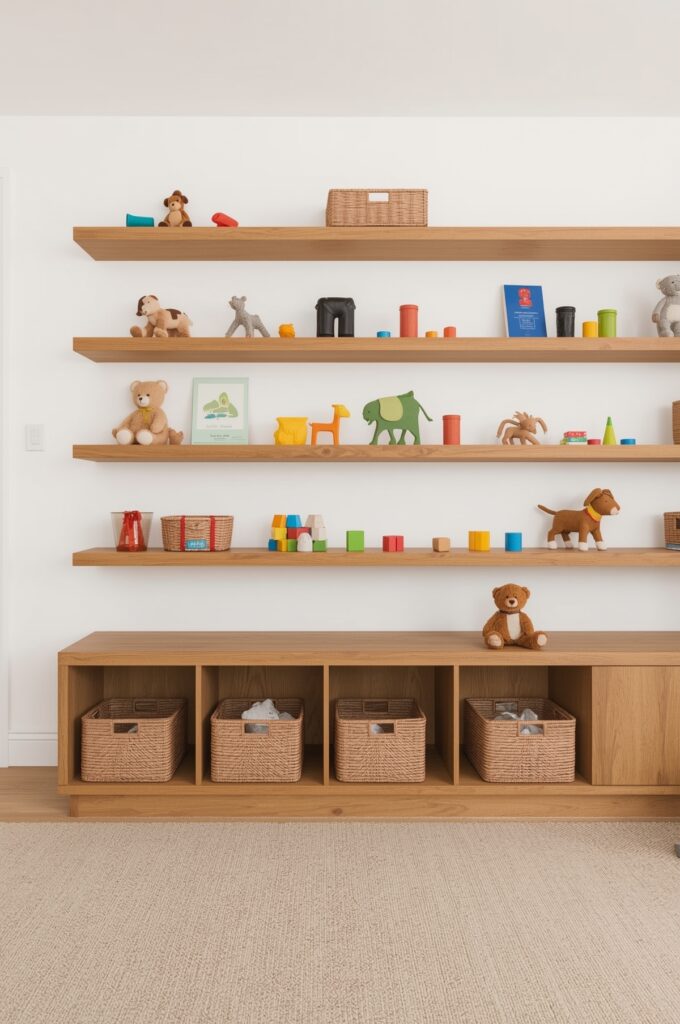
Install floating shelves to display toys neatly. They free up the floor and make the room look organized. Arrange items by size or color to create a playful display. This idea also keeps favorite toys within reach while adding a decorative touch.
3. Foldable Wall-Mounted Craft Table
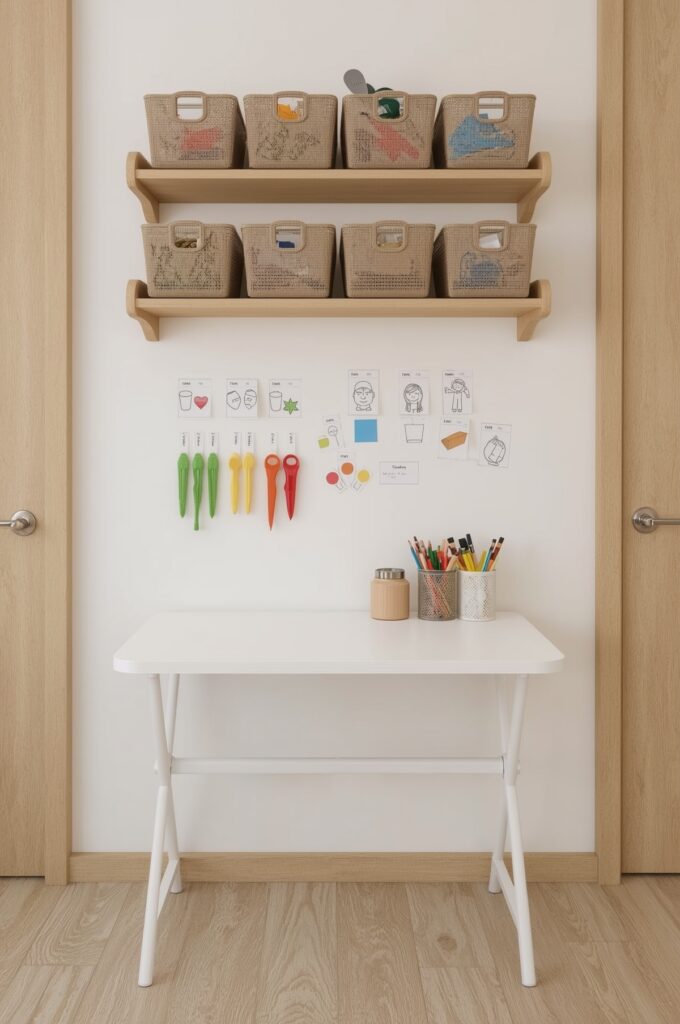
A foldable table attached to the wall saves space when not in use. Kids can pull it down for drawing, painting, or crafting. Add small wall-mounted bins nearby for art supplies. It transforms the wall into a functional and creative play station.
4. Toy Rotation Boxes for Fresh Play
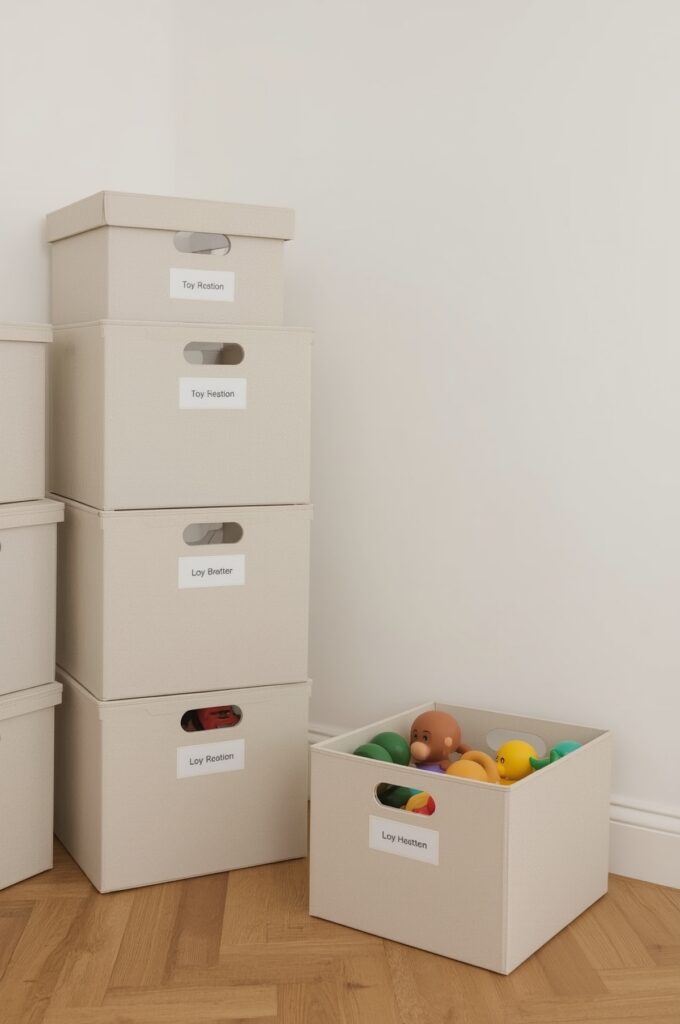
Use labeled boxes to rotate toys every week. Keep only a few out at once to reduce clutter and keep playtime exciting. This method makes old toys feel new again. Store extra boxes in a closet or under the bed.
5. Under-the-Stairs Play Hideout
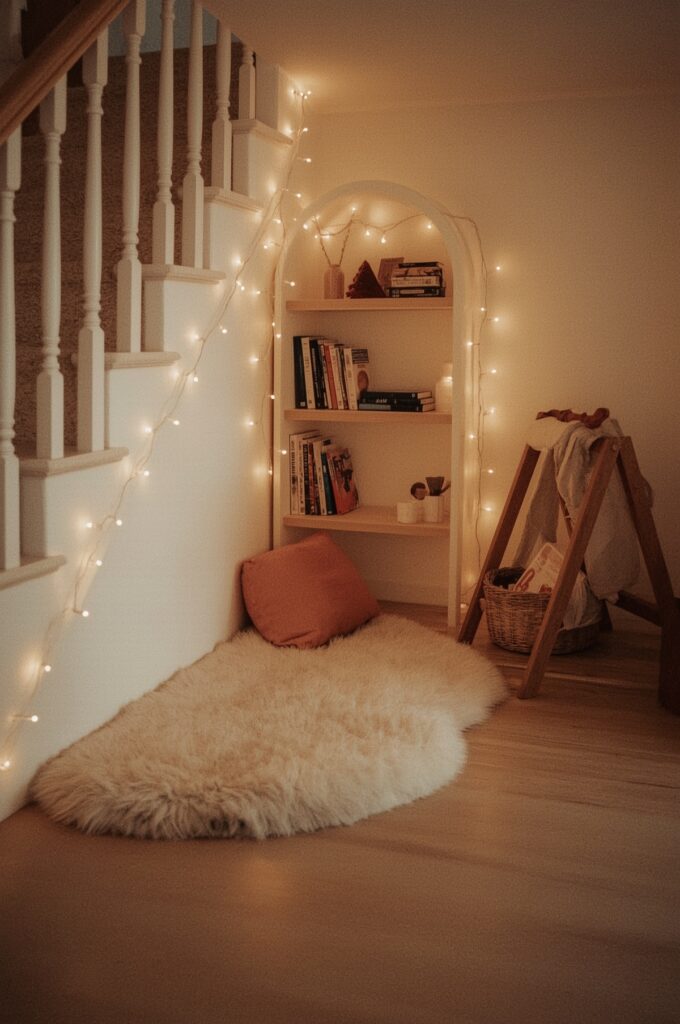
Convert the unused space under stairs into a mini hideout. Add soft mats, fairy lights, and a few shelves for books or toys. Kids will love the cozy, secret space. It makes the most of an often-overlooked area in small homes.
6. Storage Benches with Cushions
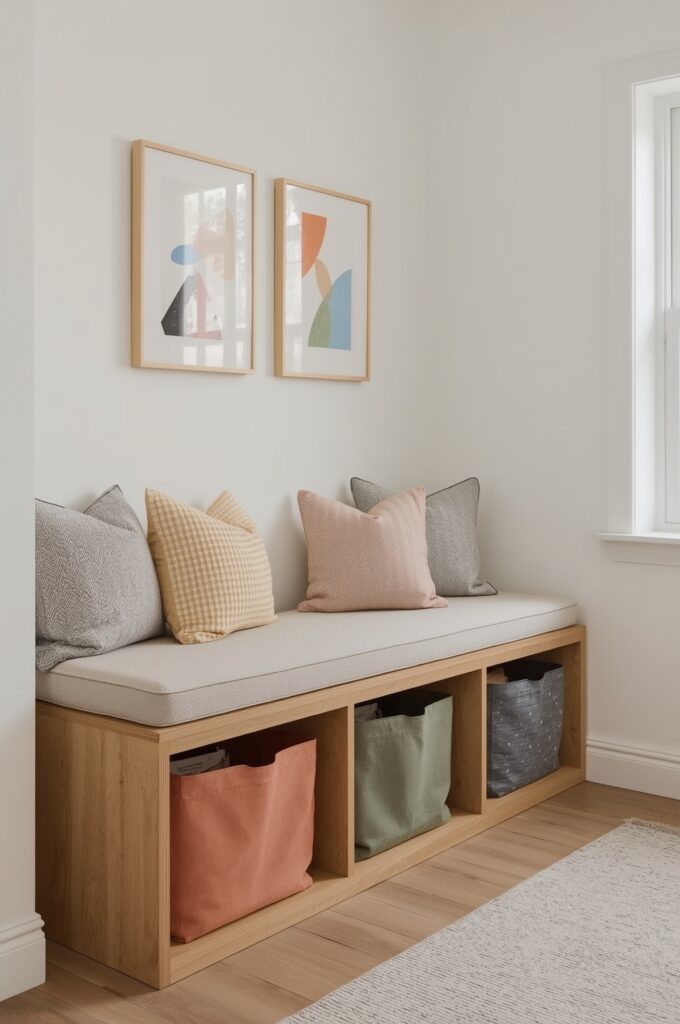
Choose benches with built-in storage compartments. They provide seating and hidden space for toys or books. Add cushions to make them comfortable for reading or resting. This dual-purpose furniture keeps the room tidy and maximizes small play areas.
7. Magnetic Chalkboard Wall Combo
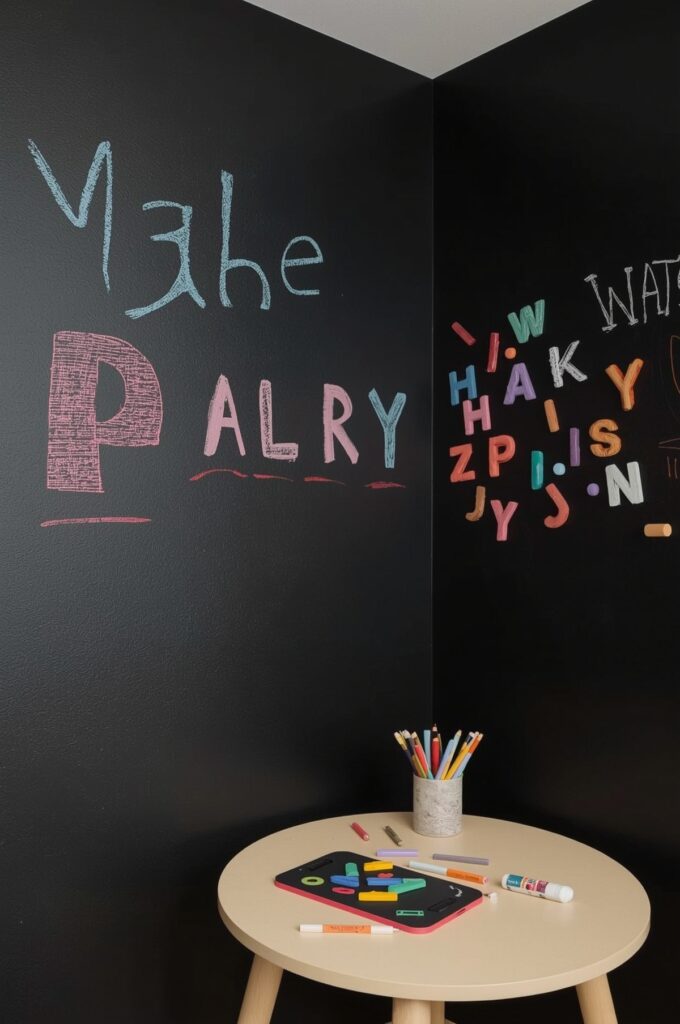
Install a wall panel that works as both chalkboard and magnetic board. Kids can draw freely or stick magnetic letters and shapes. It encourages creativity while keeping play vertical. The feature also doubles as wall décor and learning space.
8. Closet Transformed into Play Den
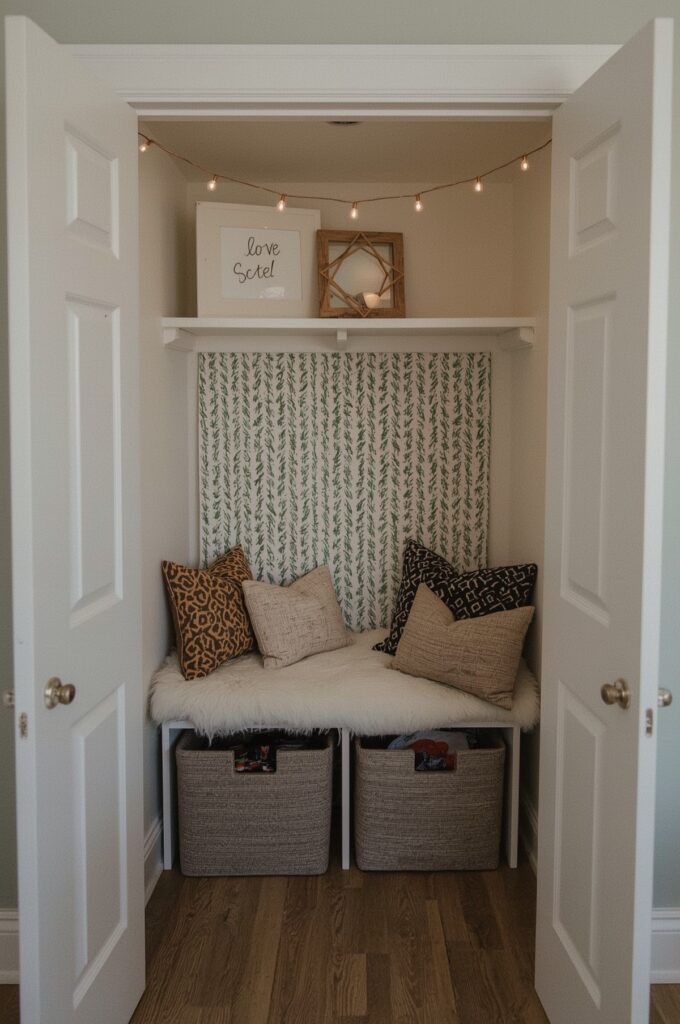
Turn an unused closet into a play den. Remove doors, add a rug, and hang string lights for a magical effect. Small shelves or bins fit perfectly inside. This idea gives kids a private, defined play zone without taking up extra space.
9. Colorful Foam Mats for Safe Play
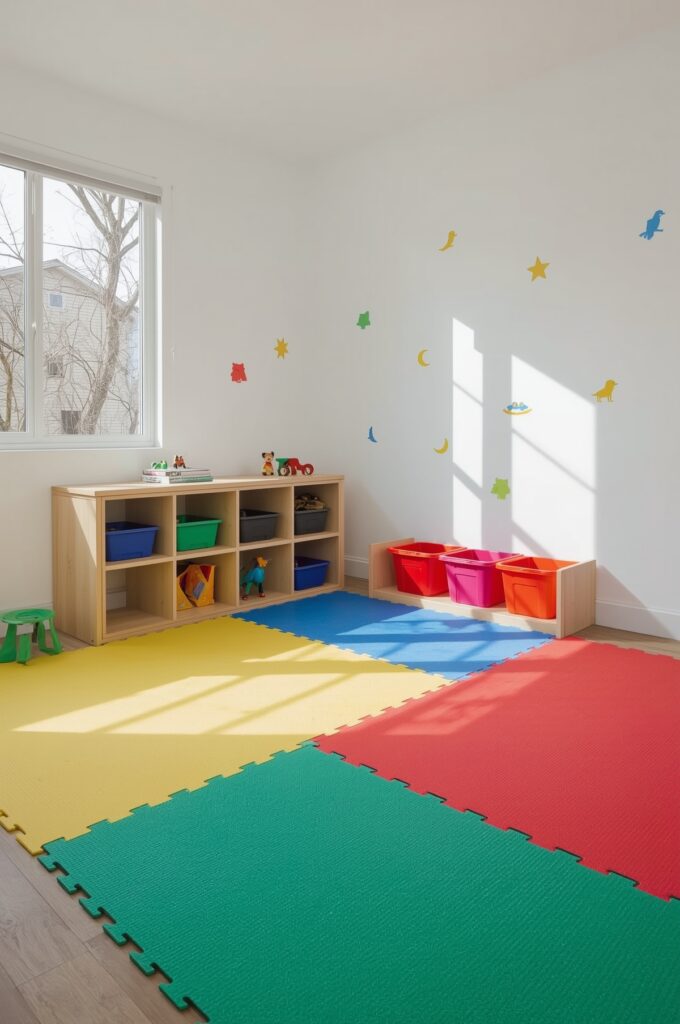
Lay down foam mats to create a cushioned floor. Bright colors add energy and define the play zone. They are easy to clean and rearrange. Mats keep kids safe during play, especially in small rooms with hard flooring.
10. Play Sofa That Doubles as a Bed
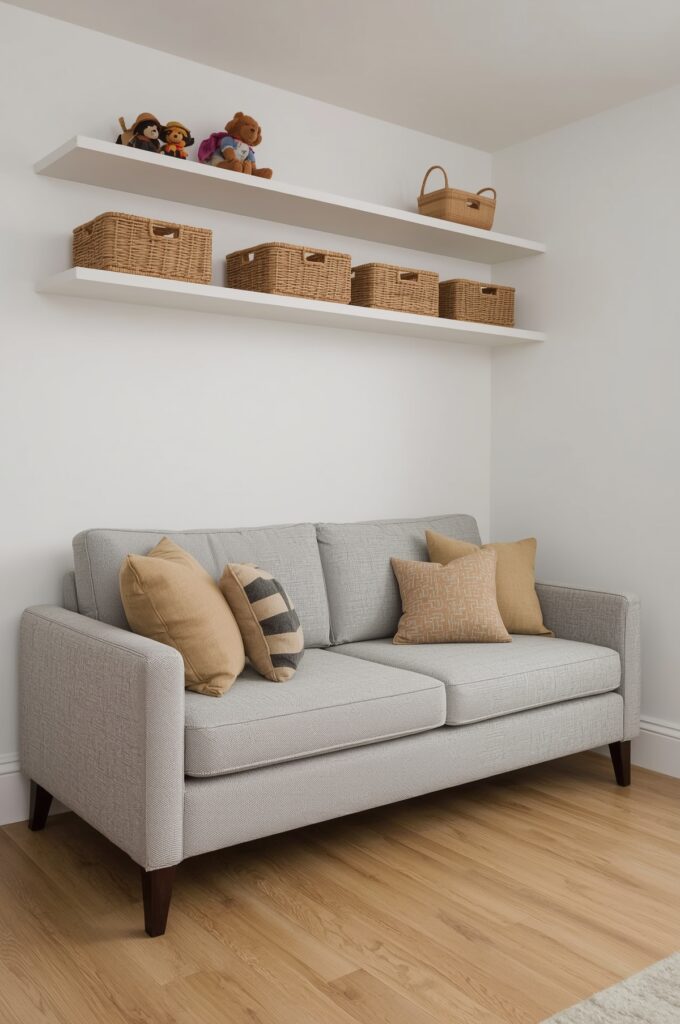
Choose a small sofa that converts into a bed. Kids can use it for lounging, play, or sleepovers. The design works well in multipurpose rooms. It saves space by serving as both play furniture and extra sleeping area.
11. Neutral Walls with Bold Toy Accents
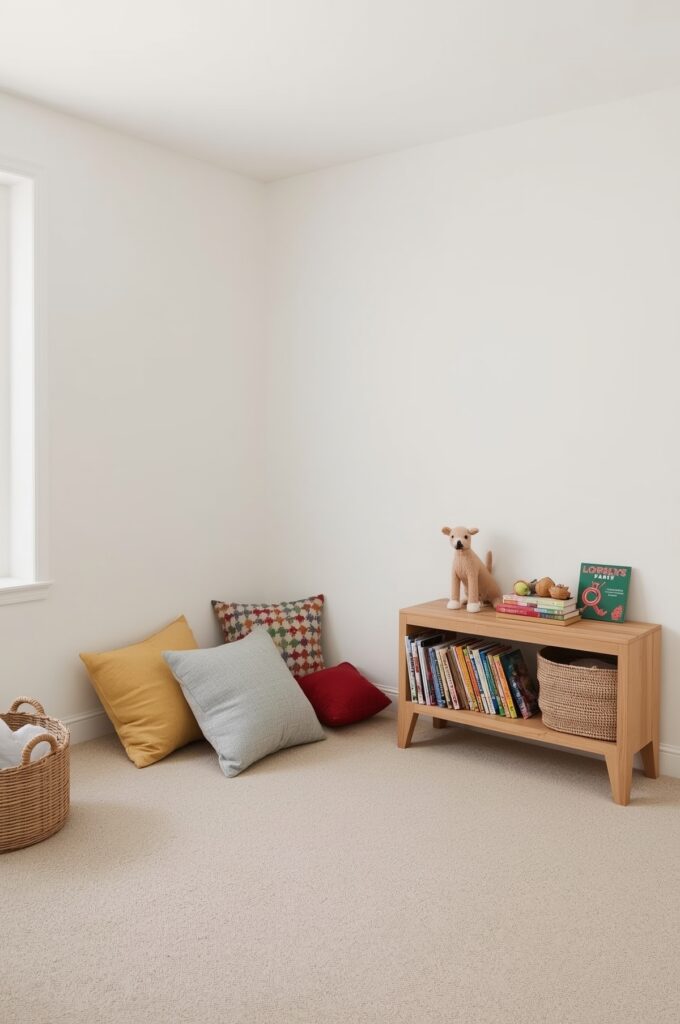
Paint walls in neutral tones to keep the room feeling open. Add bold toys, cushions, or rugs to bring in color. This balance avoids visual clutter while keeping the space lively. Neutral walls also adapt easily as kids grow.
12. Over-the-Door Hanging Storage Pockets
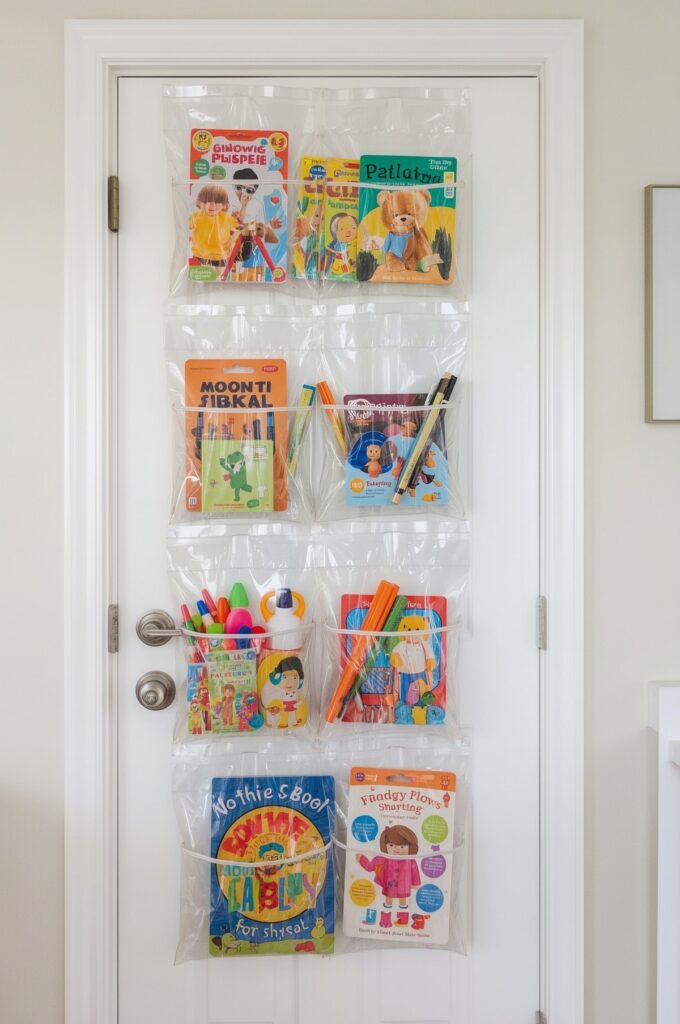
Hang storage pockets over the door to hold art supplies, small toys, or books. They save floor space and keep items organized. Clear pockets make it easy for kids to see what’s inside. This is a budget-friendly and practical solution.
13. Black-and-White Chalk Wall Section
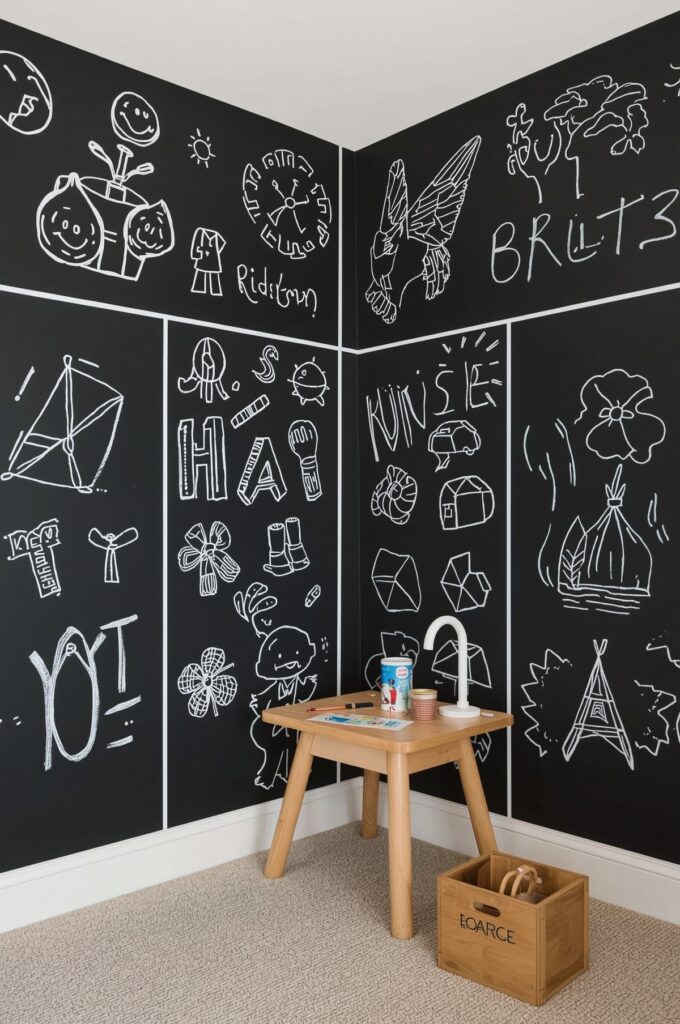
Dedicate one wall to black-and-white chalk paint. Kids can doodle freely and erase easily. The simple palette keeps the room from feeling chaotic. It adds personality without overwhelming small spaces, encouraging creativity while keeping the design sleek.
14. Pegboard Wall for Art Supplies
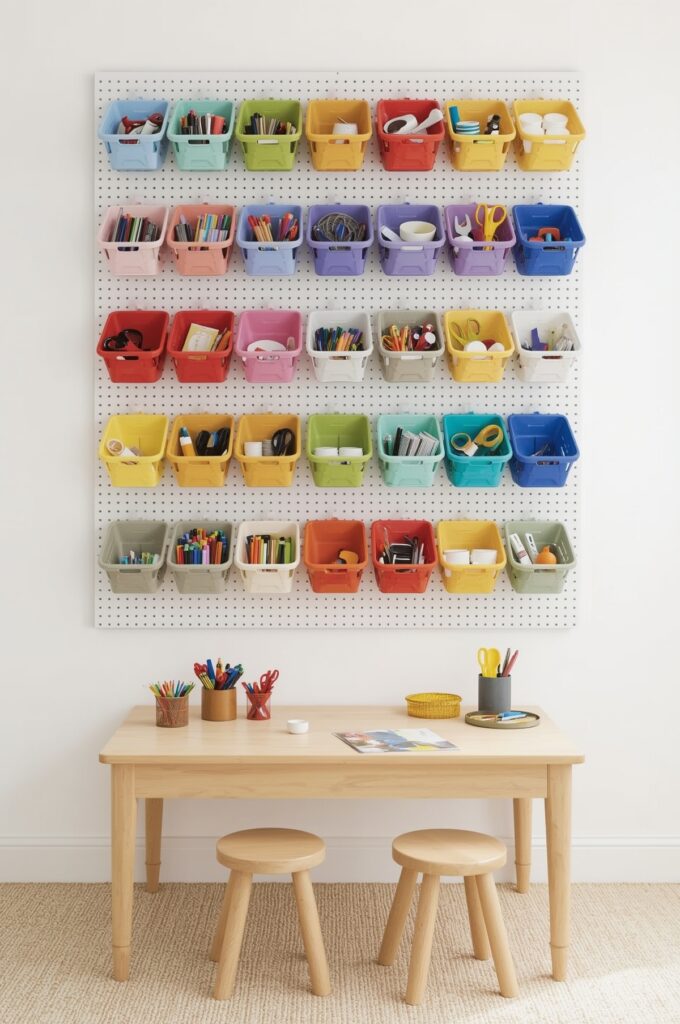
Mount a pegboard on the wall for customizable storage. Hooks, baskets, and shelves can hold supplies, toys, or books. Kids can rearrange items as needed. This idea is highly flexible and keeps everything within easy reach while freeing floor space.
15. Window Seat Toy Chest
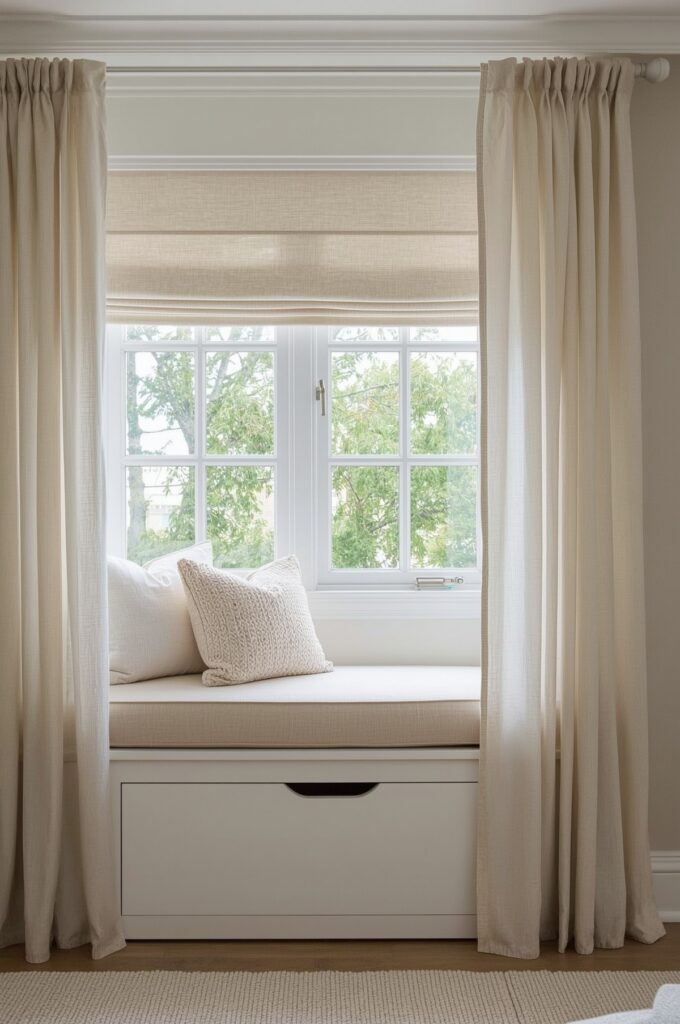
Create a window seat with built-in storage underneath. Add cushions to make it a cozy reading spot. The chest below can hold toys or books. It maximizes natural light and turns unused window areas into functional play zones.
16. Canopy Tent Reading Niche
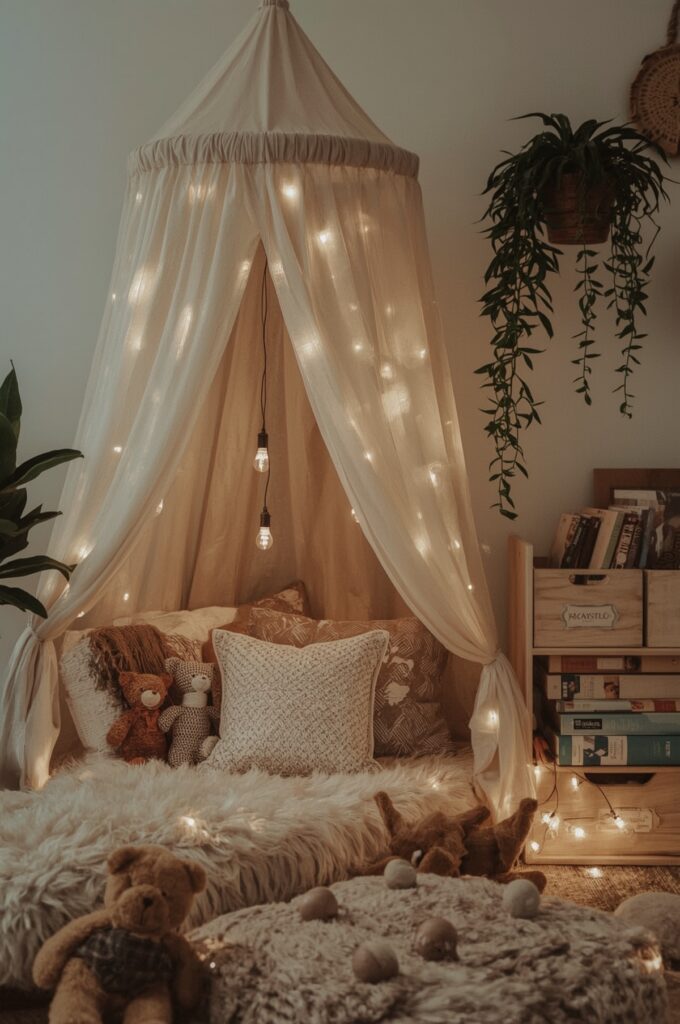
Hang a small canopy to form a reading niche. Add a rug, pillows, and soft lighting inside. The canopy creates a magical hideaway kids will love. It takes up little space but provides a big sense of adventure.
17. Nesting Tables for Art Projects
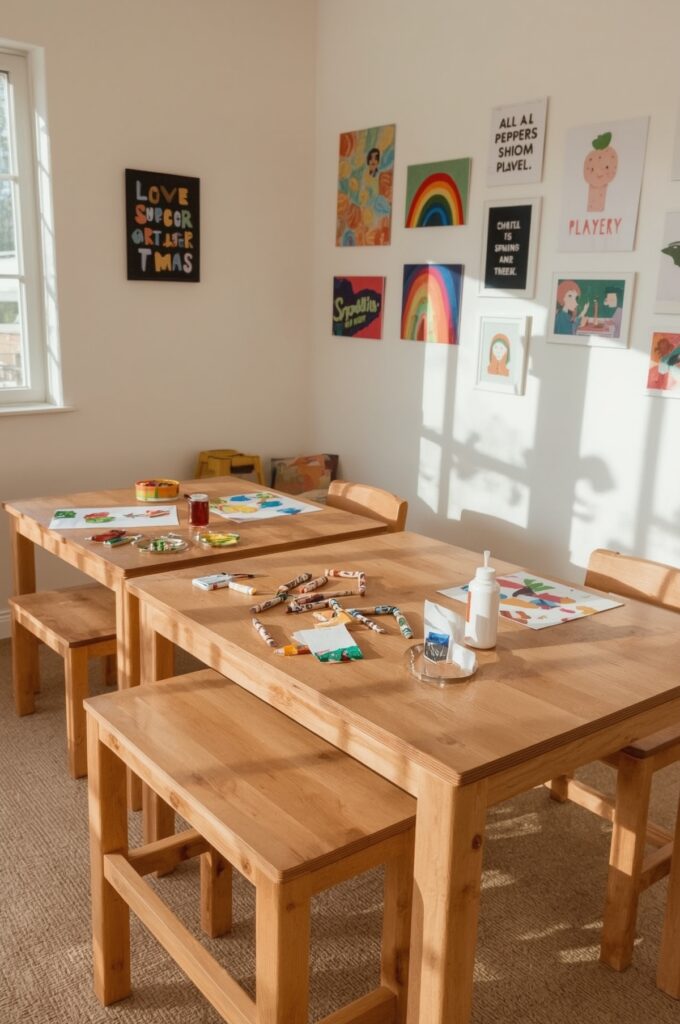
Use nesting tables for art and play. They can be pulled out during activities and stacked away when done. Their flexible design saves space and adapts to different needs. Add small chairs for a compact but functional setup.
18. Rolling Cart for Building Blocks
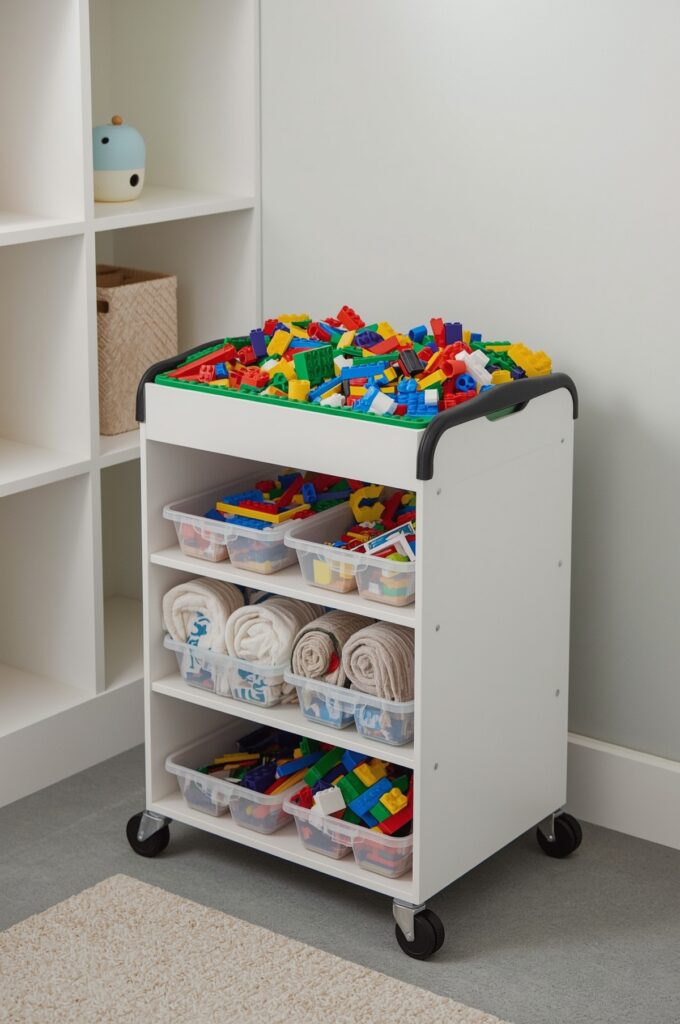
A rolling cart is perfect for storing building blocks. Kids can move it easily around the room. The cart keeps blocks contained and makes cleanup simple. Multiple levels allow separation by size or type, keeping the playroom organized.
19. Clear Bins with Labels for Organization
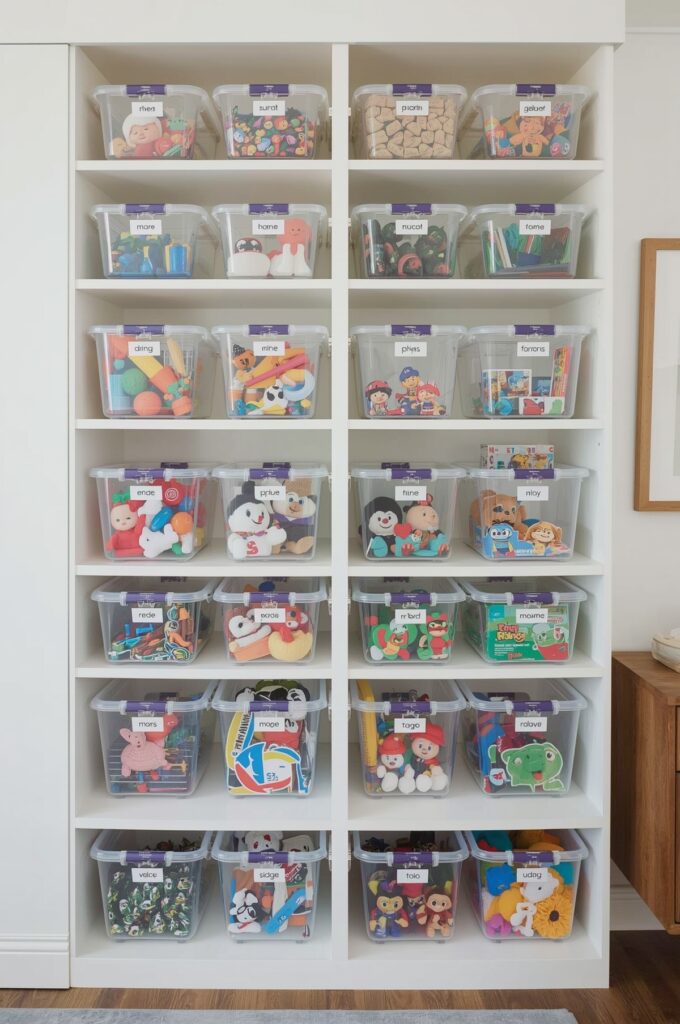
Store toys in clear bins with simple labels. Kids can see exactly what’s inside, making cleanup faster. Group toys by category for easy access. This method keeps small playrooms tidy and teaches children responsibility for their belongings.
20. Hanging Pod Swing Chair
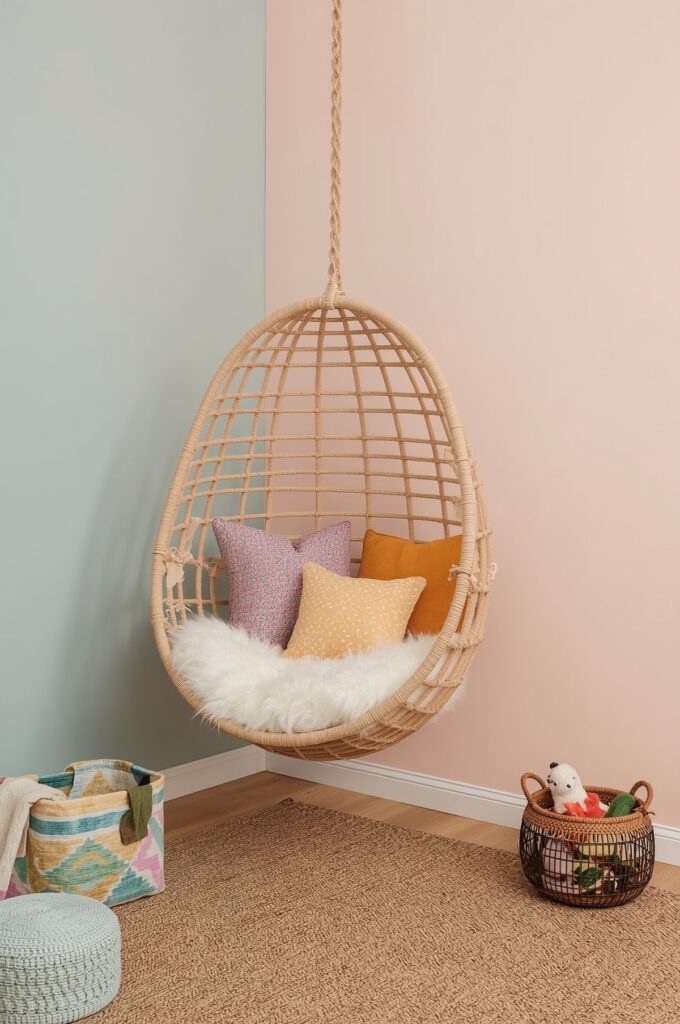
Install a pod swing chair from the ceiling. It offers kids a fun spot to relax, read, or sway gently. The hanging design keeps the floor open for play. Add cushions inside for comfort and style.
21. Loft Bed with Play Zone Below
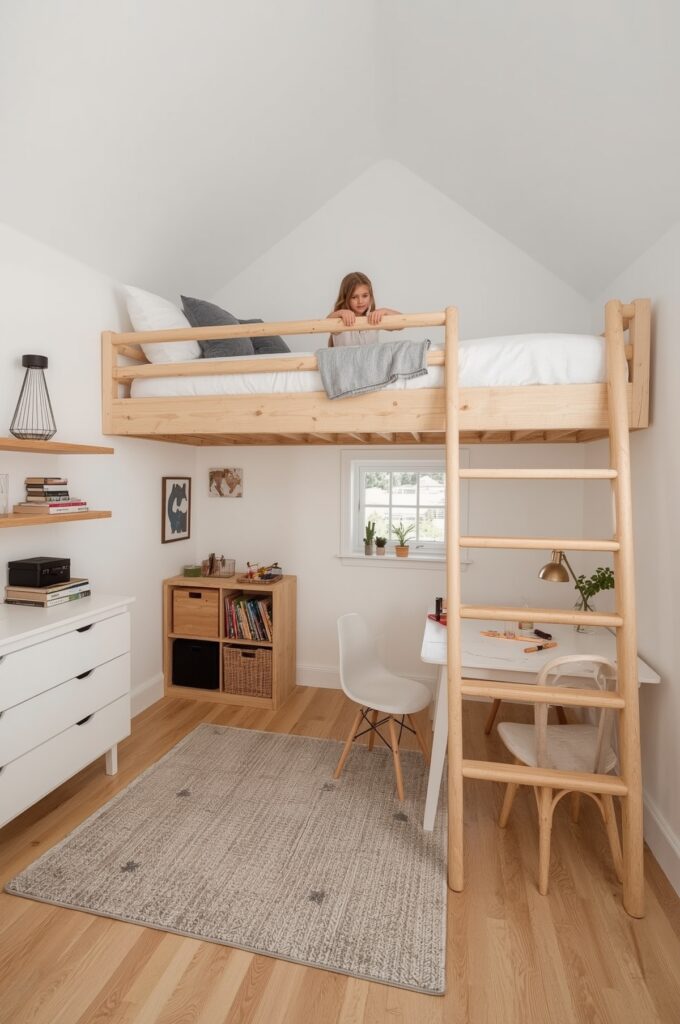
A loft bed frees up floor space for play. The top provides sleeping space while the bottom becomes a mini play zone. Add rugs, shelves, or a small table underneath. It creates two functional areas in the footprint of one.
22. Pop-Up Teepee Tent for Pretend Play
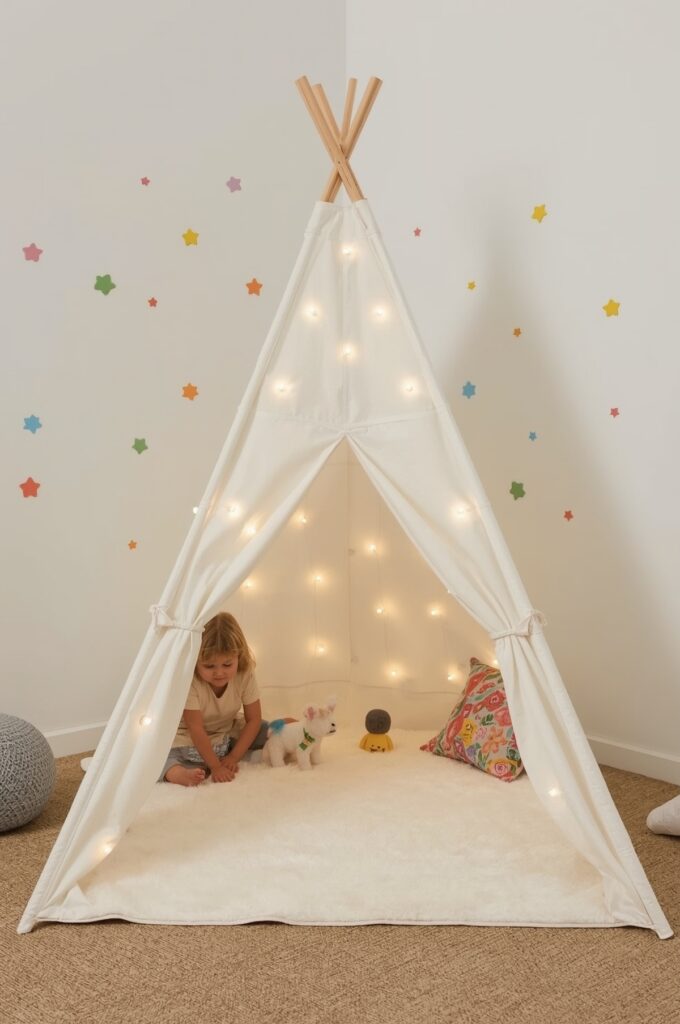
A foldable teepee tent offers imaginative fun. Kids can use it for role play, reading, or quiet time. When not in use, it folds away easily. This compact idea adds adventure without overwhelming small rooms.
23. Narrow Book Ledges for Storytime
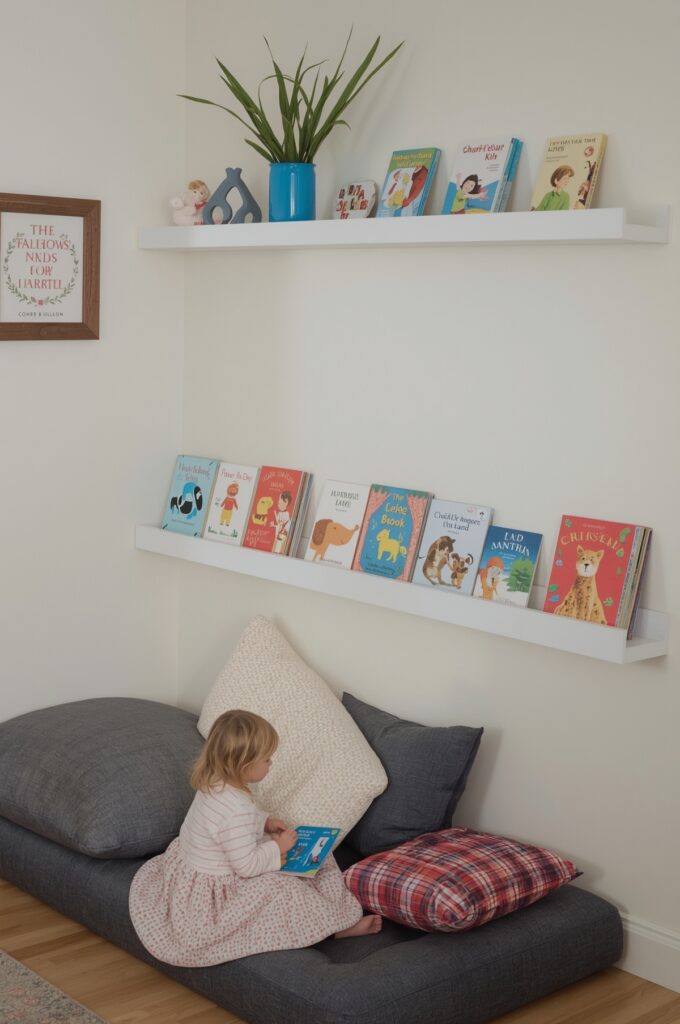
Install slim ledges on the wall to display books facing forward. They take little depth and double as décor. Kids can see covers easily, encouraging reading. Ledges save space compared to bulky bookcases.
24. Foldable Play Rug with Patterns
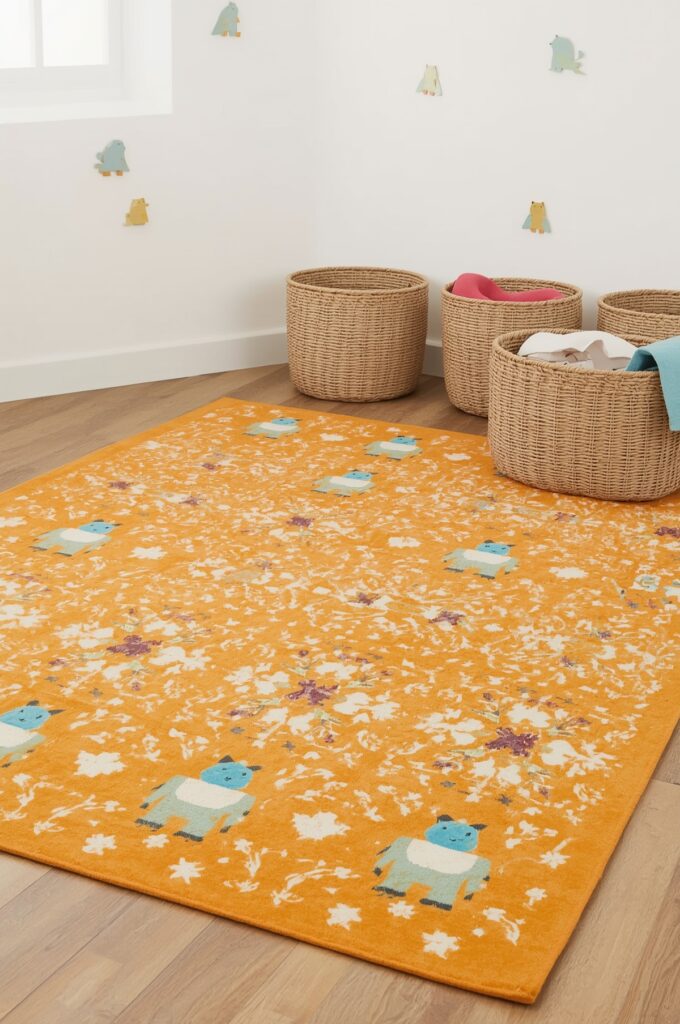
Choose a play rug that folds up neatly. Bright patterns inspire games and learning. When folded, it frees up valuable floor area. It is easy to clean, portable, and perfect for small rooms.
25. Guest Room with Hidden Play Zone
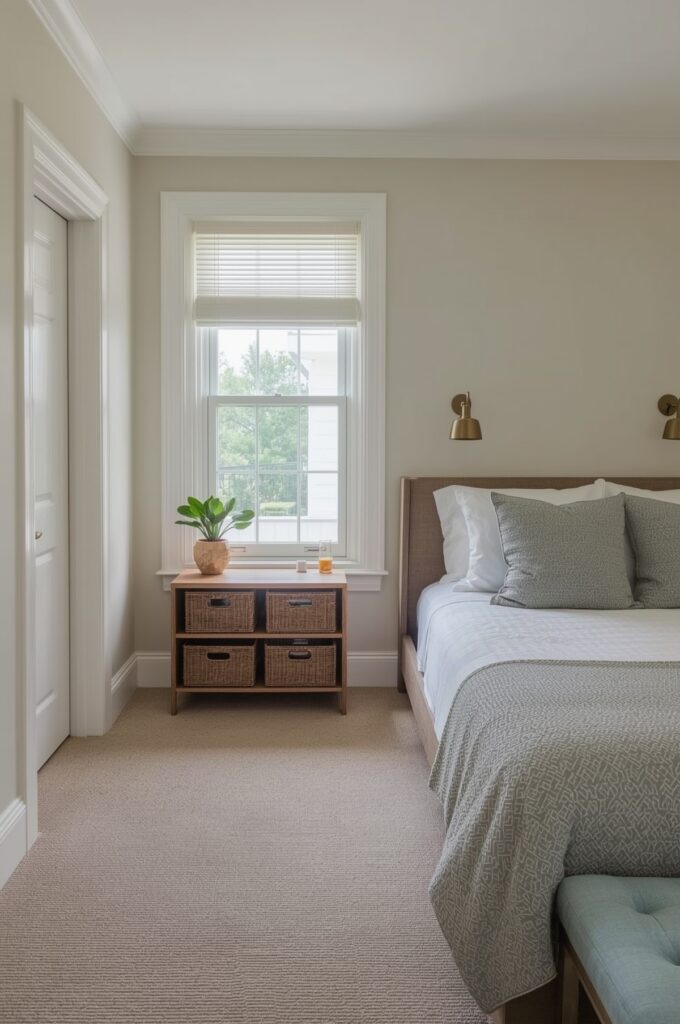
Design a dual-purpose guest room with a play corner. Use foldable furniture and discreet toy storage. Guests see a neat space, while kids still have a playful zone. This keeps both functions balanced in one room.
26. Full-Length Mirror to Create Illusion of Space
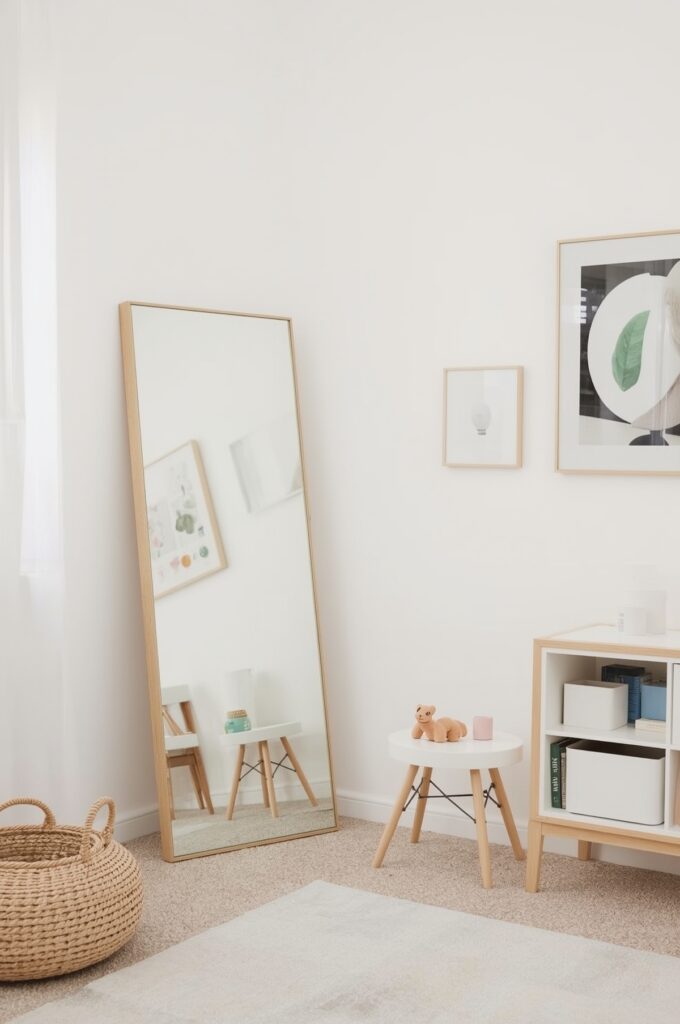
Add a tall mirror to make the room feel bigger. It reflects light and creates visual depth. Kids also enjoy watching themselves play. Place it securely for safety while enhancing the small playroom’s openness.
27. Themed Wall Decals for Imagination
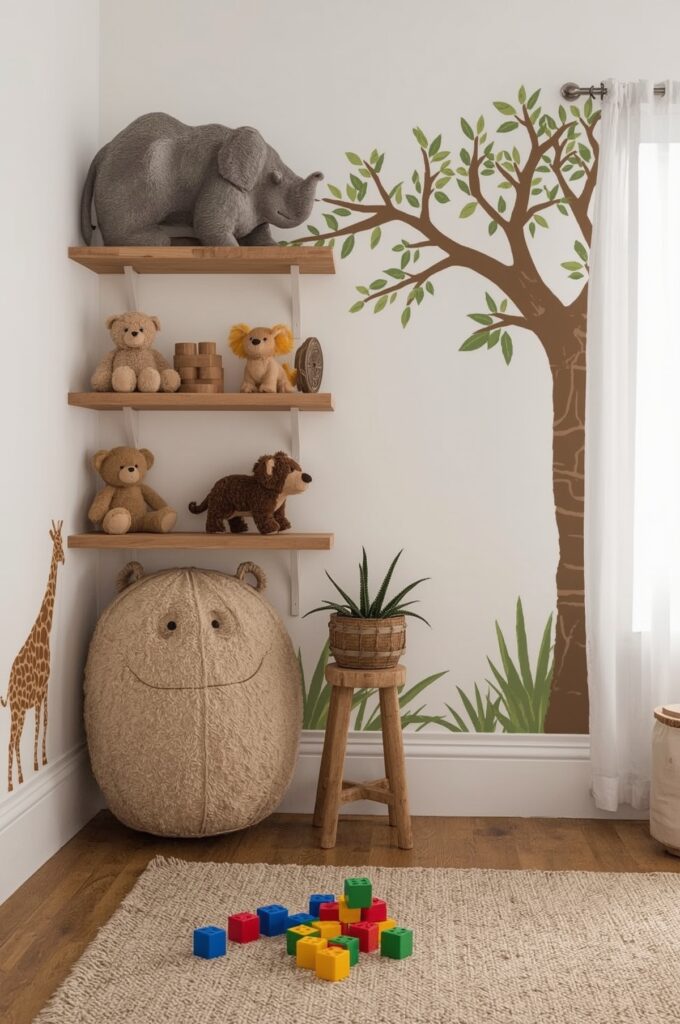
Use peel-and-stick decals to set a playful theme. Whether it’s jungle animals or space rockets, decals inspire storytelling. They are easy to remove and change as kids grow. This adds fun without using extra space.
28. Slim-Leg Furniture for Airy Feel
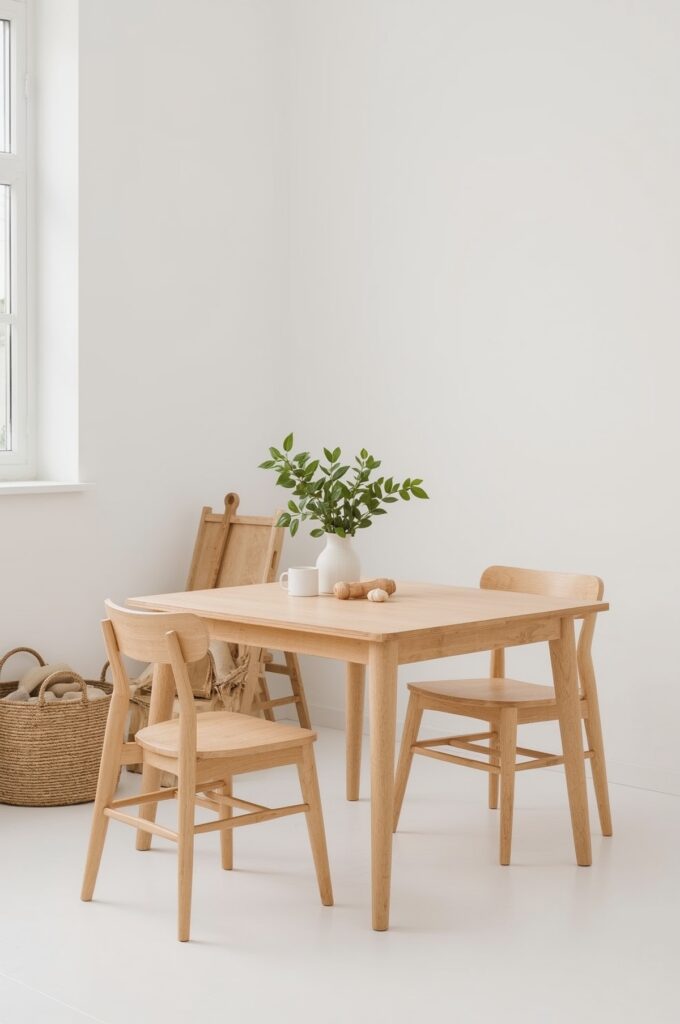
Opt for furniture with slim, visible legs. It makes the room feel light and uncluttered. The visible floor space under the furniture visually enlarges the area. This design trick is perfect for compact playrooms.
29. Color Block Paint to Define Zones
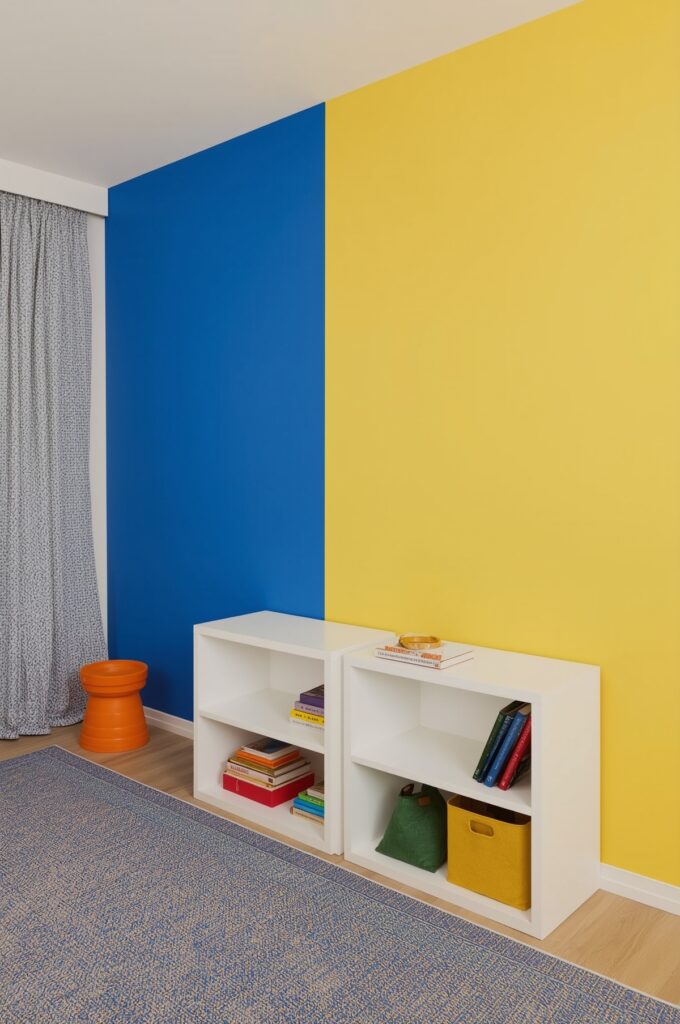
Use paint to separate zones without furniture. Different colors on walls or corners highlight reading, play, or art areas. This creates structure while saving space. Kids learn to associate colors with specific activities.
30. Hidden Toy Chest Ottoman
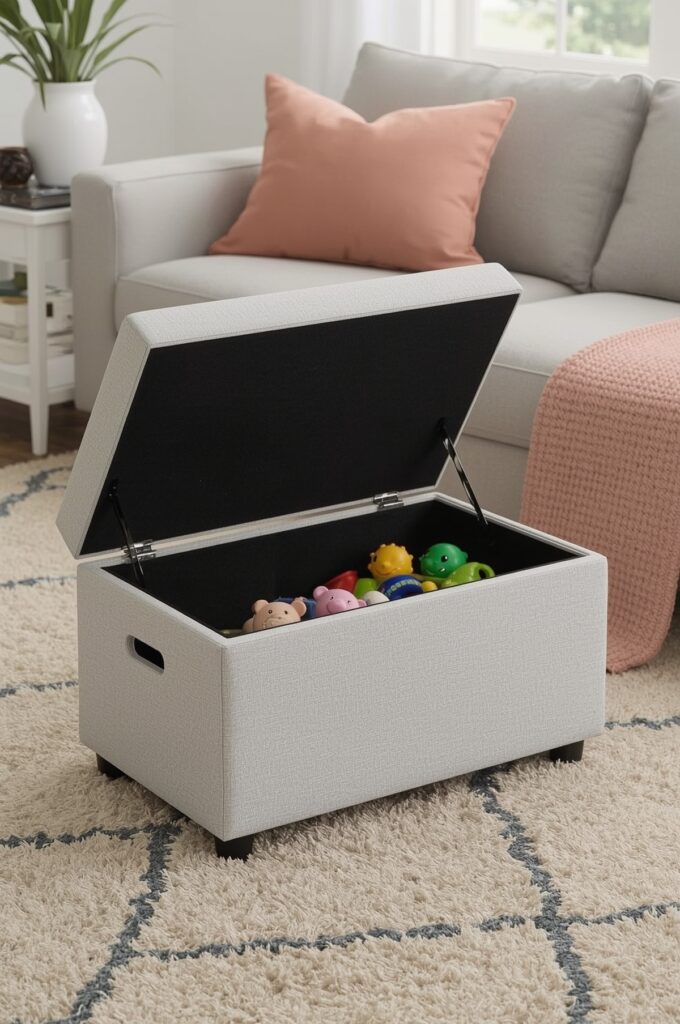
A soft ottoman with hidden storage doubles as seating. It conceals toys while keeping them close at hand. The top can serve as a table or footrest. This versatile piece blends function and style in small spaces.
31. Tiered Storage Rack for Puzzles
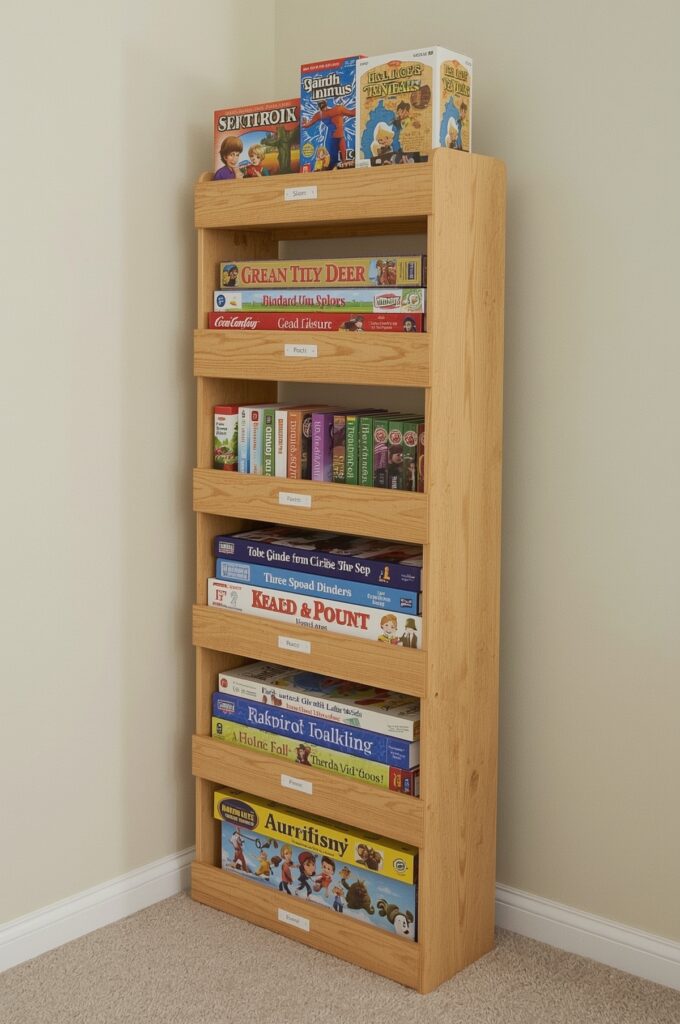
Tiered racks store puzzles and board games vertically. They save shelf space and make it easy to find pieces. The design keeps sets neat and accessible. This helps reduce clutter in small playrooms.
32. Under-Window Bench with Baskets
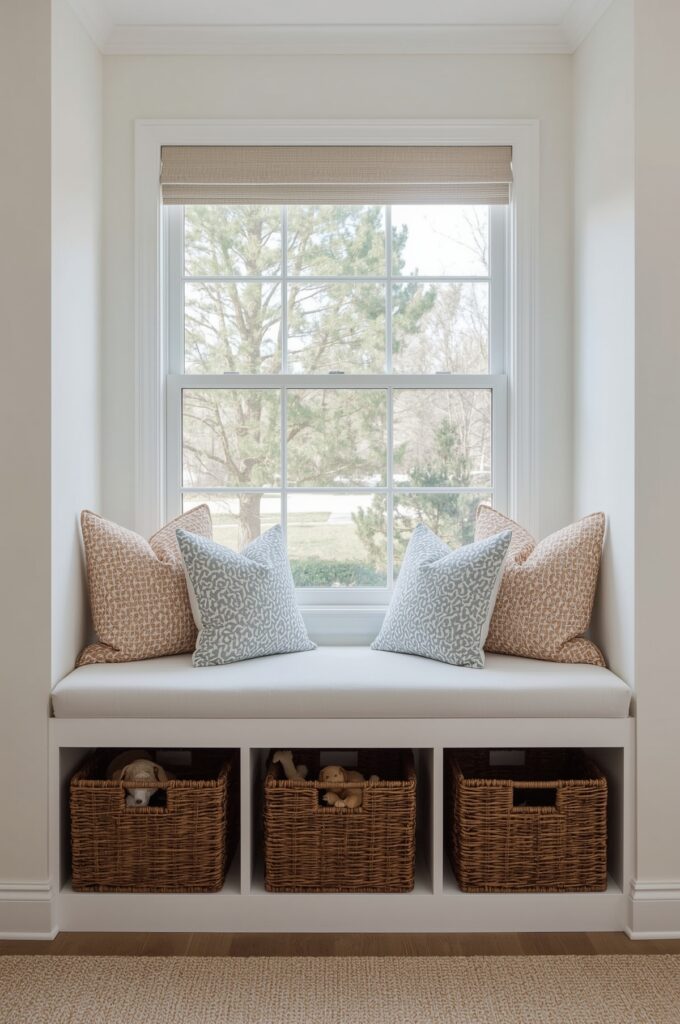
Place a bench under the window with baskets underneath. The bench becomes a reading spot while baskets hold toys. Natural light makes the corner inviting. It transforms unused window areas into useful storage and seating.
33. Compact Mobile Art Station
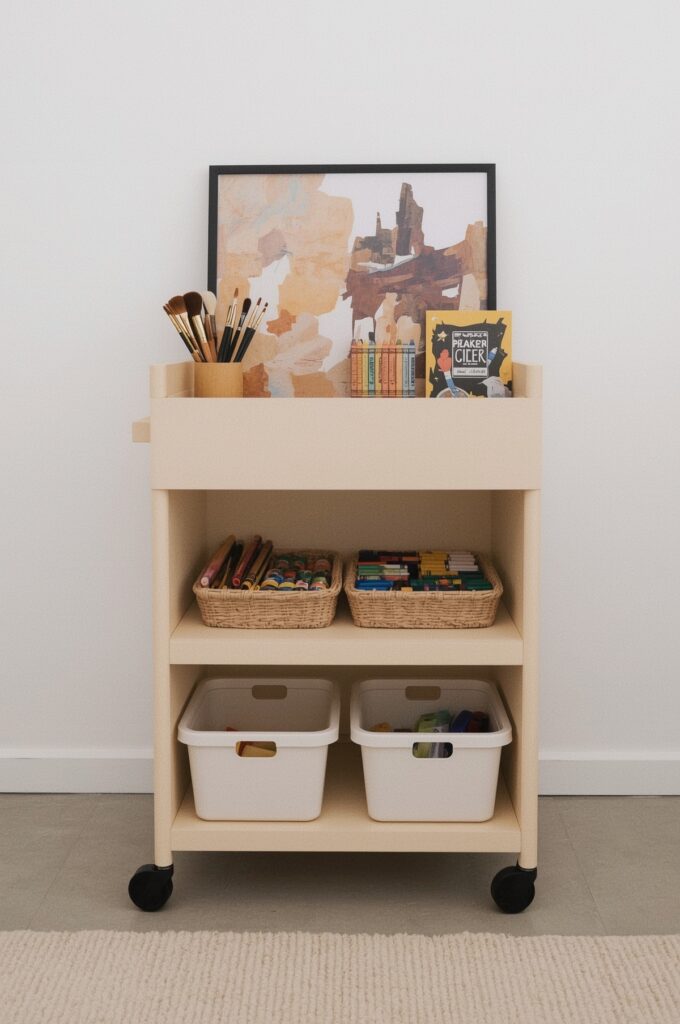
Use a slim trolley as a mobile art station. It holds markers, paints, and paper. Kids can roll it to any spot for creativity. When finished, the cart tucks away neatly, saving space.
34. Stackable Floor Cushions for Relaxing
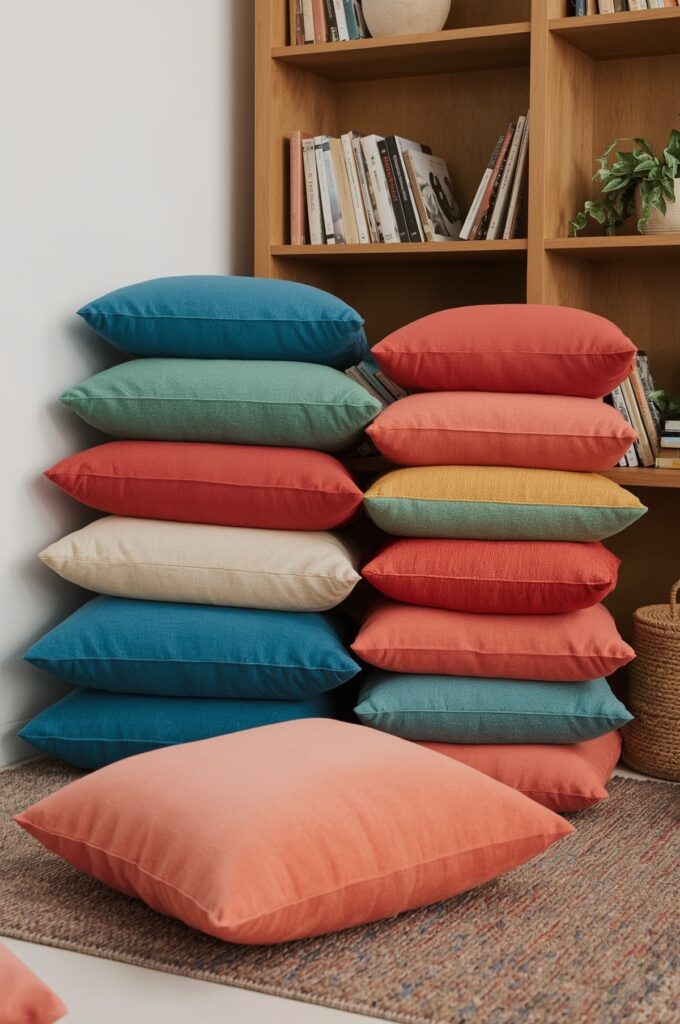
Add stackable cushions for seating and play. Kids can spread them out or stack them to save space. Cushions bring color and comfort without bulk. They adapt easily for reading, lounging, or group play.
35. Rope Hanging Wall Baskets
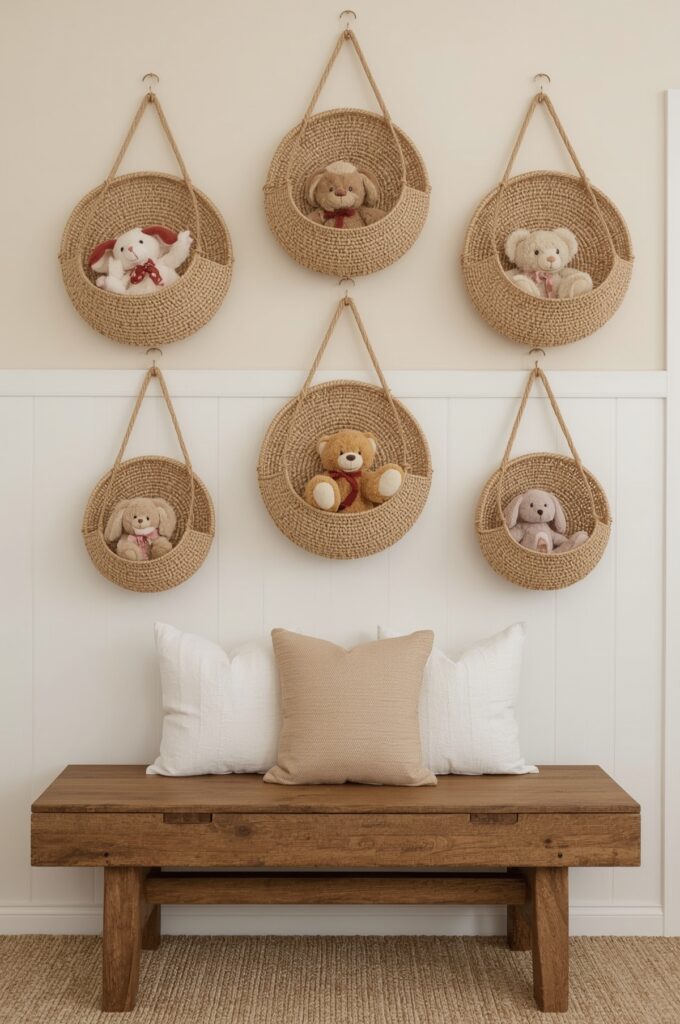
Install rope baskets on the wall for lightweight storage. They hold stuffed animals, dolls, or soft toys. The baskets add texture while keeping items off the floor. They also bring a cozy, rustic touch to the room.
36. Wall Pegs for Dress-Up Costumes
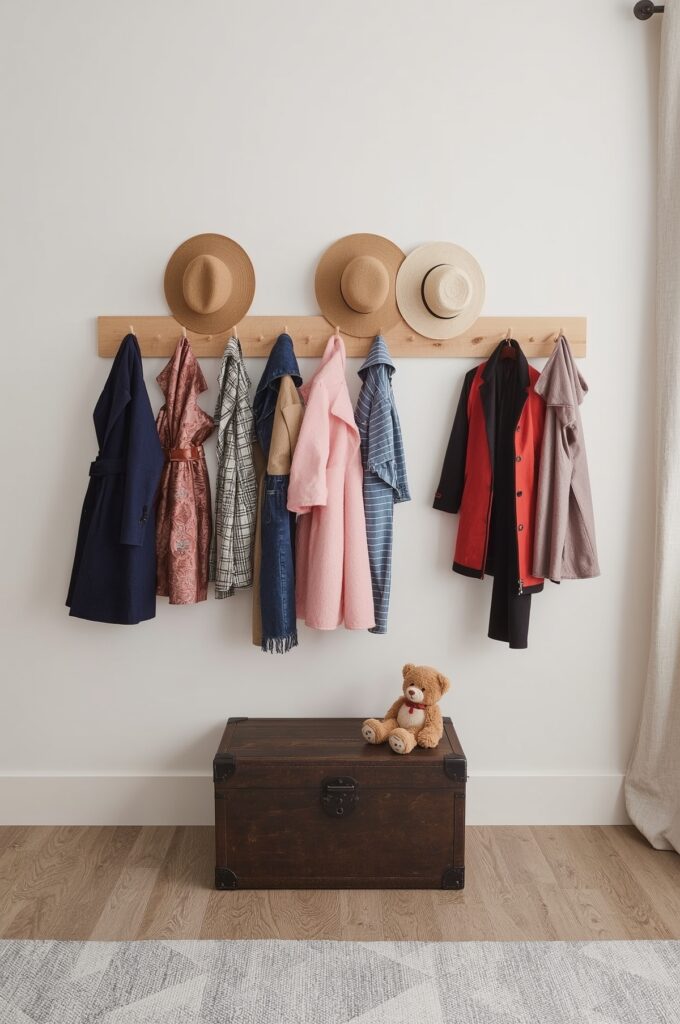
Use wall pegs to hang costumes, hats, or play accessories. This keeps outfits visible and organized. Kids can grab items easily for pretend play. The setup adds function and a fun display element.
37. Rotating Decor by Season or Holiday
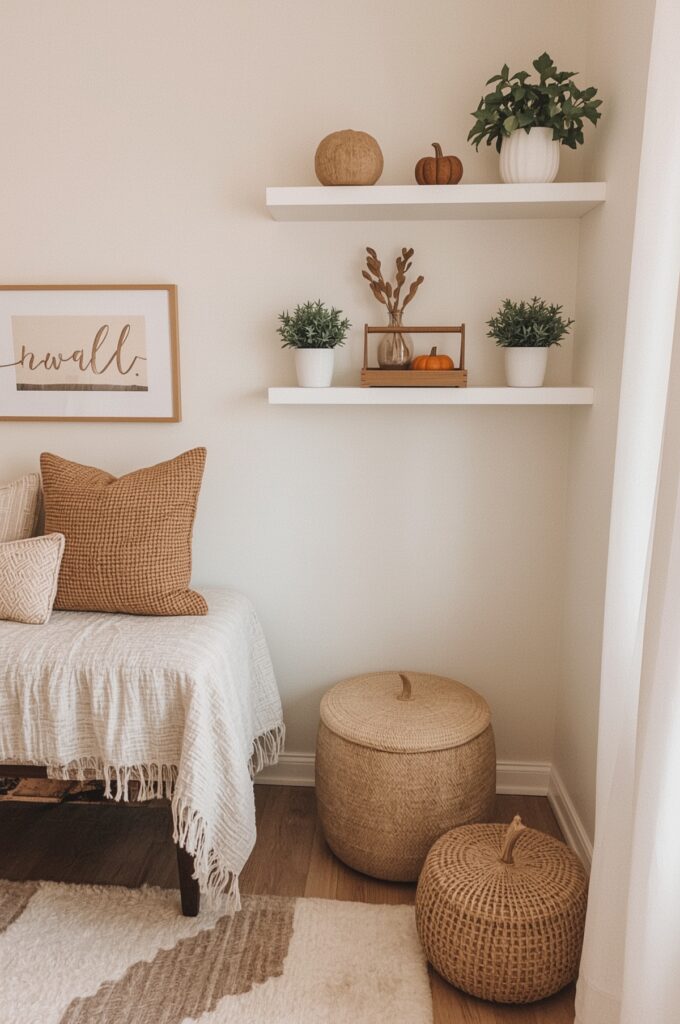
Change décor with the seasons to keep the playroom fresh. Use themed pillows, wall art, or small rugs. Rotating décor keeps the space exciting without adding permanent clutter. It also gives kids something new to look forward to.
38. Built-In Wall Cubby Shelves
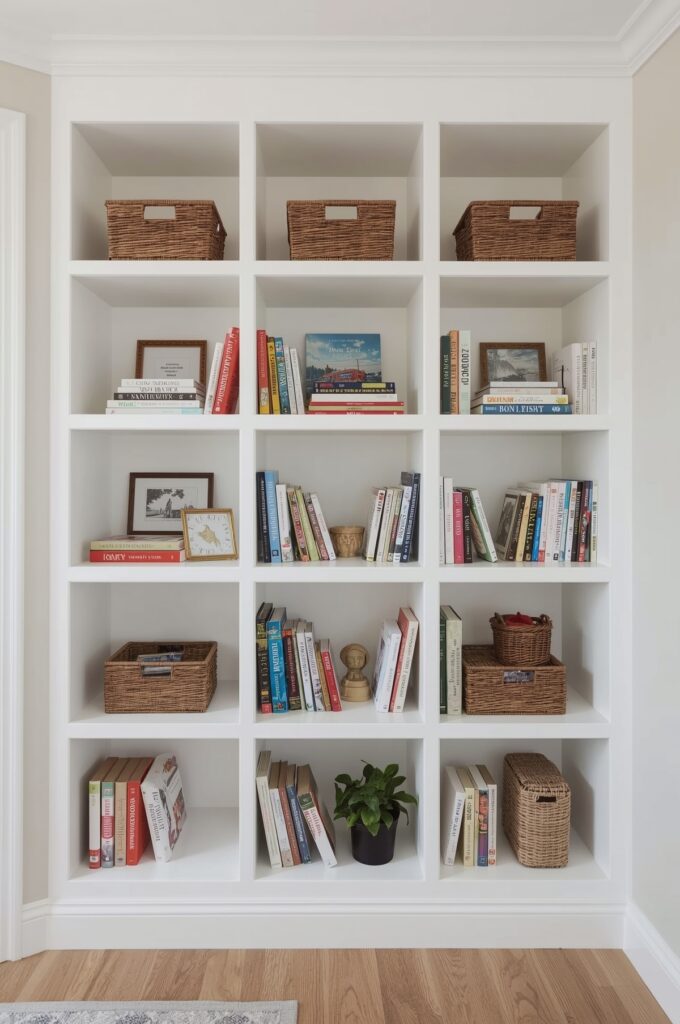
Custom cubbies maximize every inch of wall space. Each cubby can store a different type of toy or book. The design keeps everything visible and organized. Built-ins also create a polished, tailored look in small playrooms.
39. Soft Ambient Lighting Fixtures
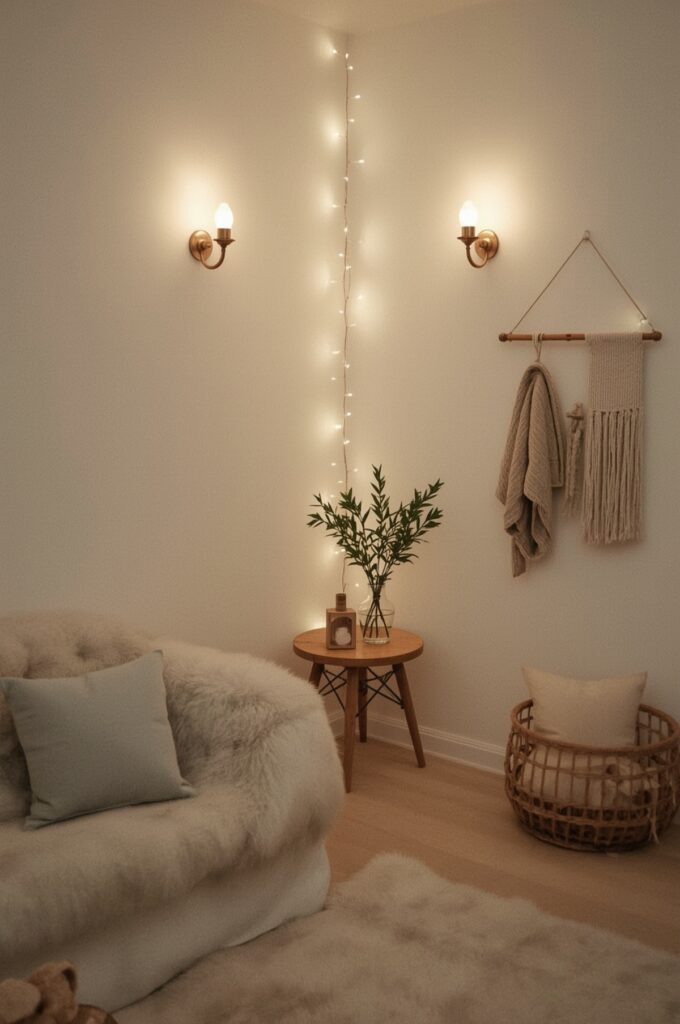
Install soft lighting to create a cozy atmosphere. Wall sconces or fairy lights work well in tight spaces. Good lighting enhances playtime and reduces strain. It also helps make small rooms feel warm and inviting.
40. Slim Homework Desk Corner
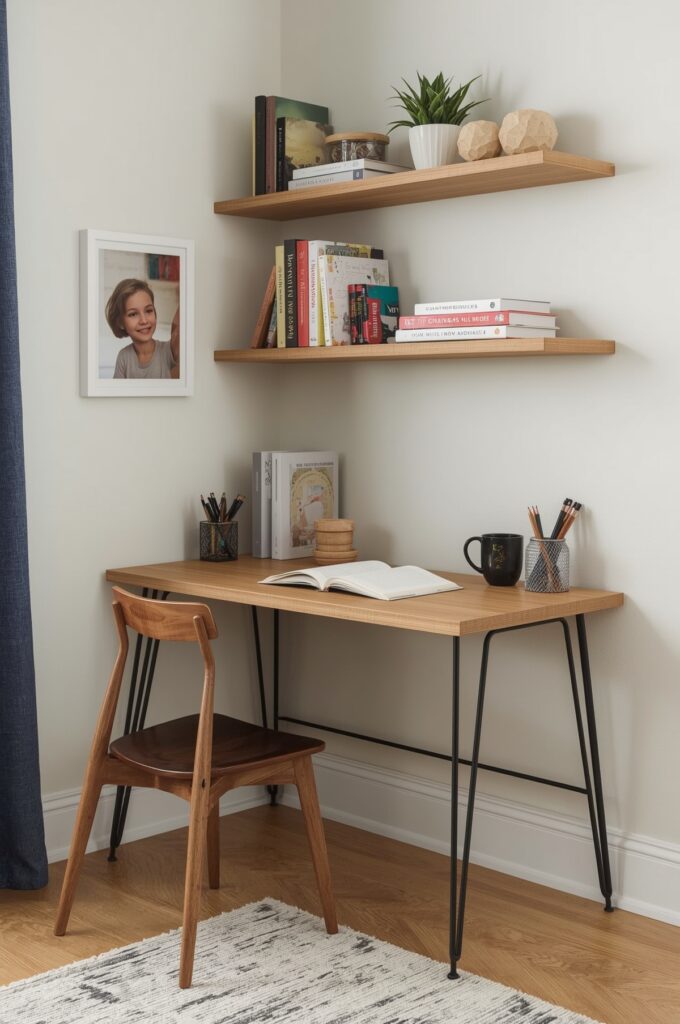
Designate a slim desk in a corner for homework or art. It doesn’t take up much space but offers a defined work zone. Add a small chair and wall shelf above. This keeps learning materials organized and accessible.
41. Wall-Mounted Toy Car Display Track
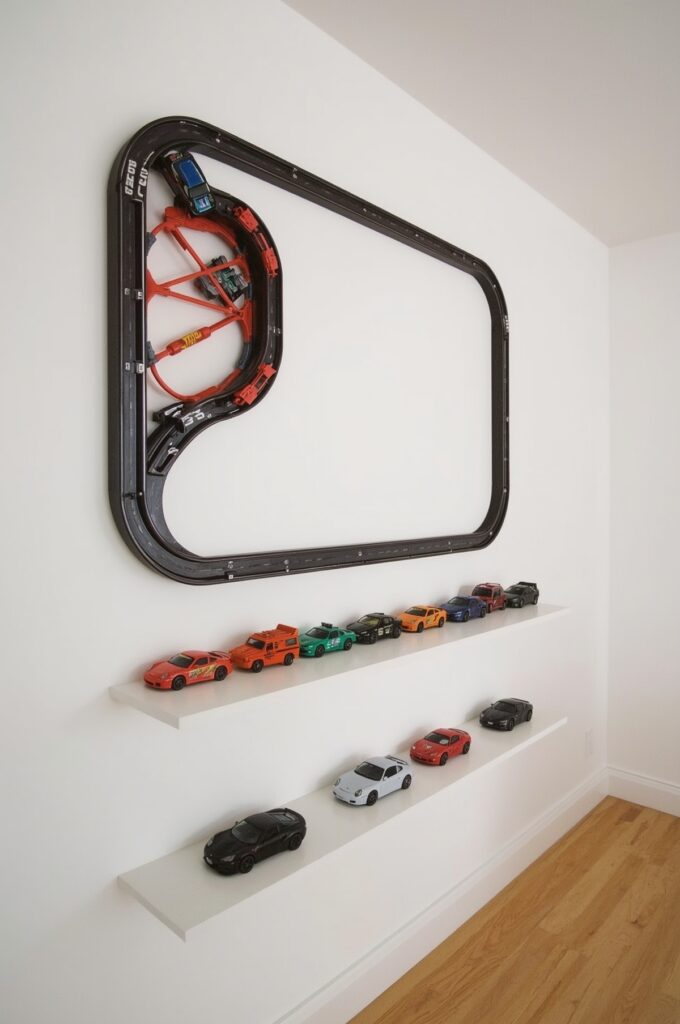
Turn a wall into a playful racetrack by adding mounted car tracks. This saves floor space while keeping toy cars organized. Kids can enjoy racing vertically, and the display doubles as wall art. It’s functional, fun, and adds excitement to a small playroom.
42. Minimalist Open Floor with One Anchor Piece
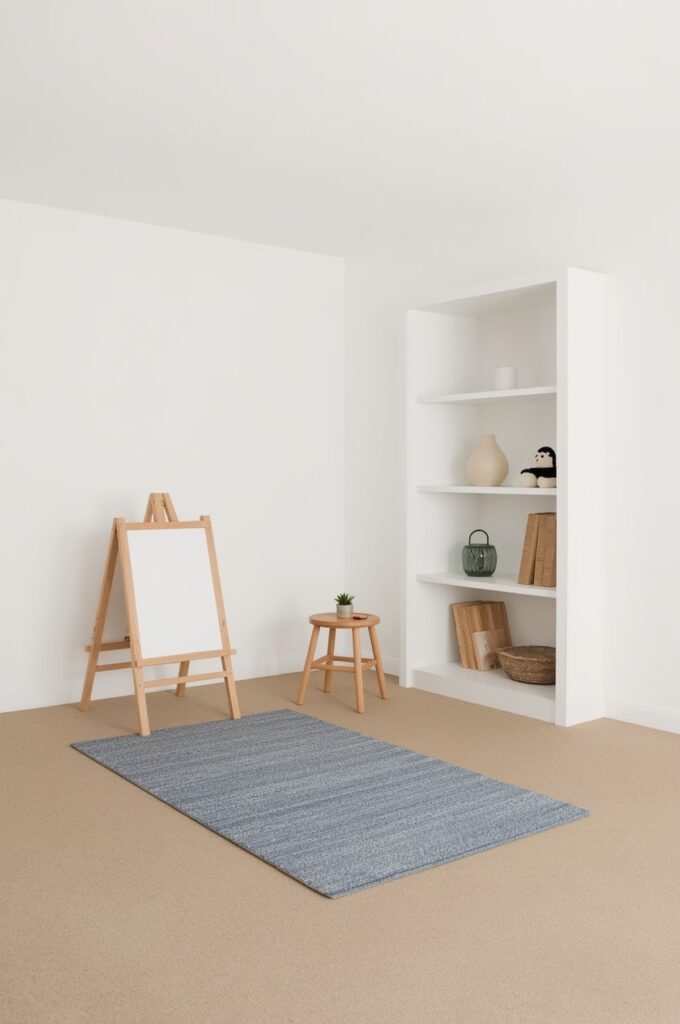
Keep the playroom simple by leaving most of the floor clear. Choose one anchor piece, like a bookshelf, a reading nook, or an art easel. This setup gives kids room to move while ensuring the space feels open, uncluttered, and versatile.
43. Rugs to Create Visual Play Zones
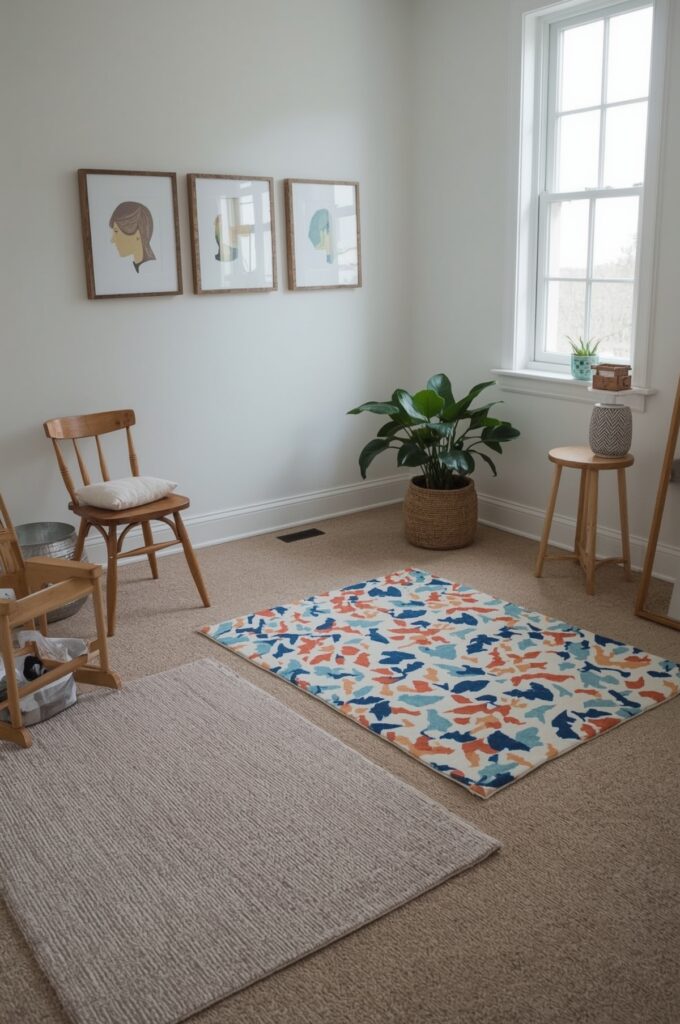
Use rugs to divide the playroom into small activity areas. A soft rug can mark a reading corner, while a patterned rug can highlight the building zone. Rugs create structure without bulky dividers, and they bring warmth, comfort, and design flair to the space.
44. Compact Wooden Play Kitchen
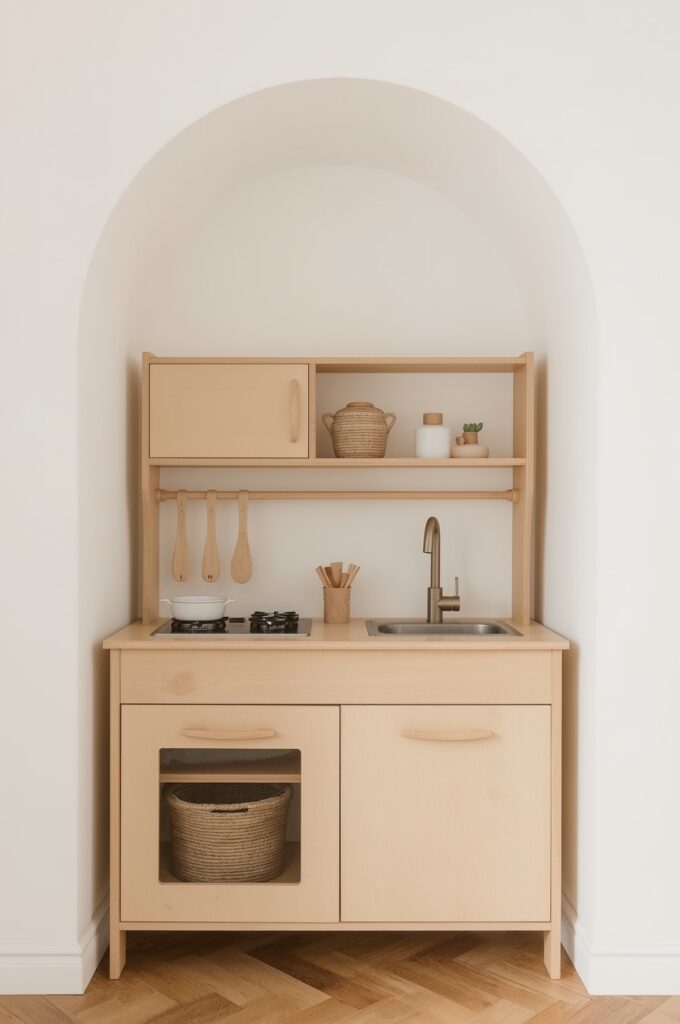
Select a small wooden play kitchen that fits into a corner or narrow wall. Even a slim version can include pretend stoves, ovens, and sinks. It encourages role play while using minimal space. Compact designs blend seamlessly into multipurpose rooms without overwhelming them.
45. Curtains to Conceal Storage Units
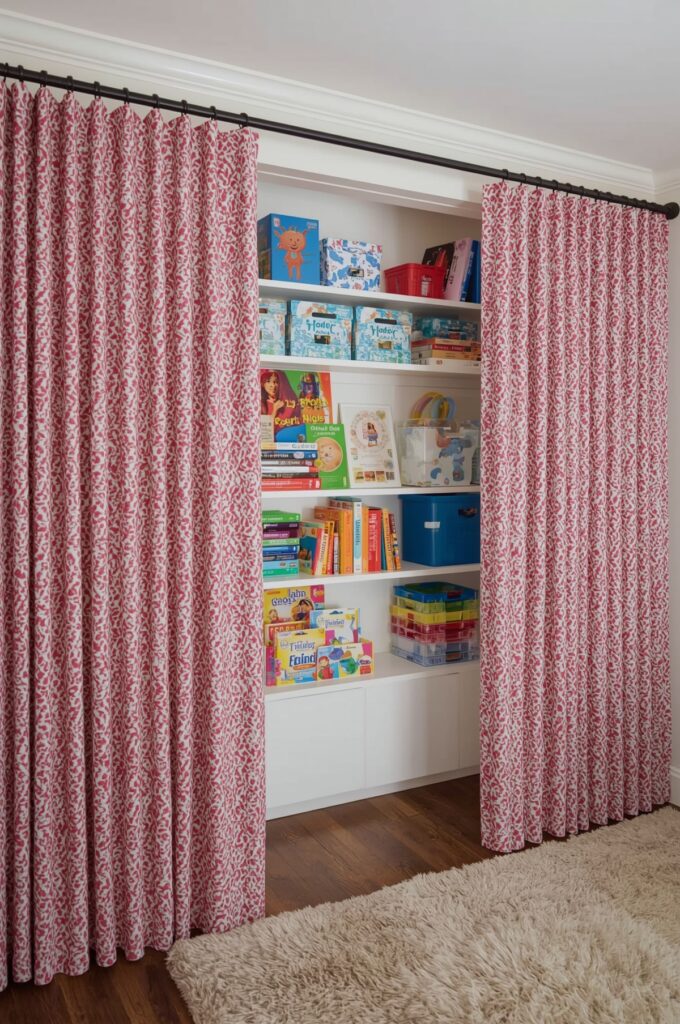
Add curtains in front of shelves or cubbies to hide clutter instantly. They keep the room looking neat while still allowing easy access to toys. Choose fabrics with bright colors, patterns, or playful themes to add personality to the room while serving a practical function.
46. Game Shelf for Puzzles and Boards
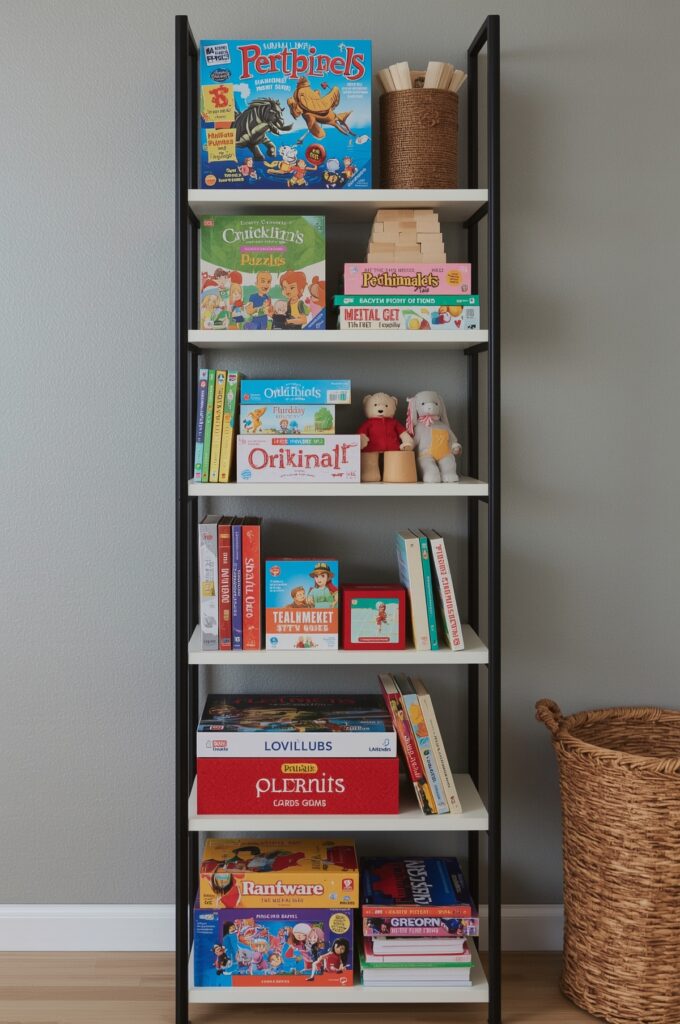
Dedicate a slim shelf just for puzzles and board games. Storing them upright prevents damage and saves space. Clearly labeled sections make it simple for kids to grab and return games. This organization reduces mess and ensures activities stay accessible in small playrooms.
47. Small Indoor Climbing Wall Panel
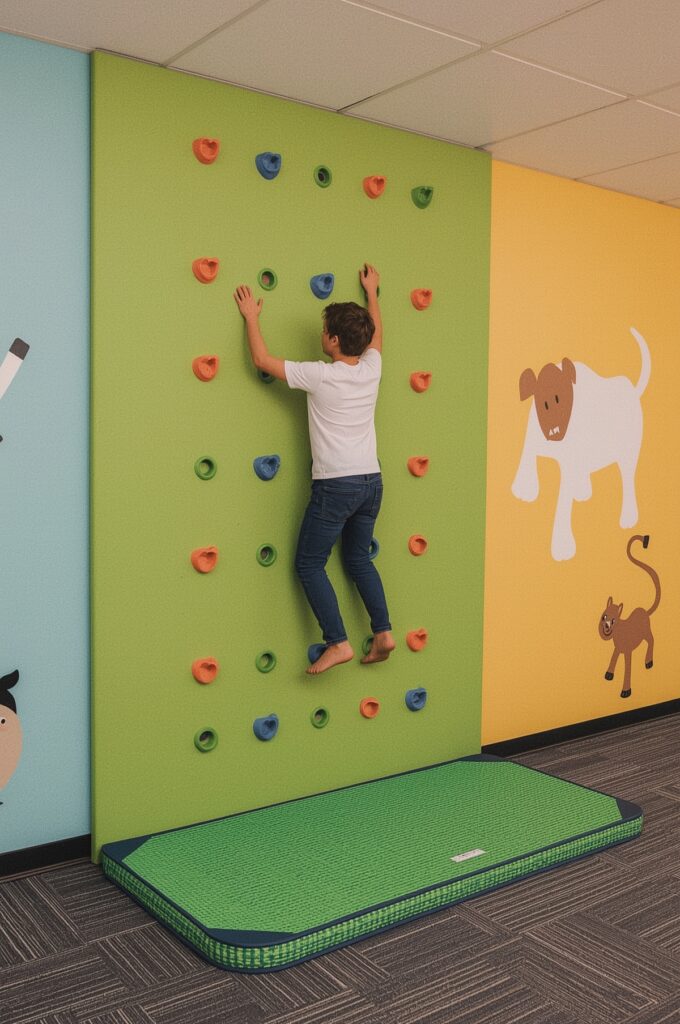
Bring adventure indoors with a compact climbing wall section. Even a small panel can provide exercise, motor skill development, and hours of fun. Use safety mats underneath for protection. This feature turns a plain wall into an active play station without taking over the room.
48. Pull-Out Under-Bed Storage Drawers
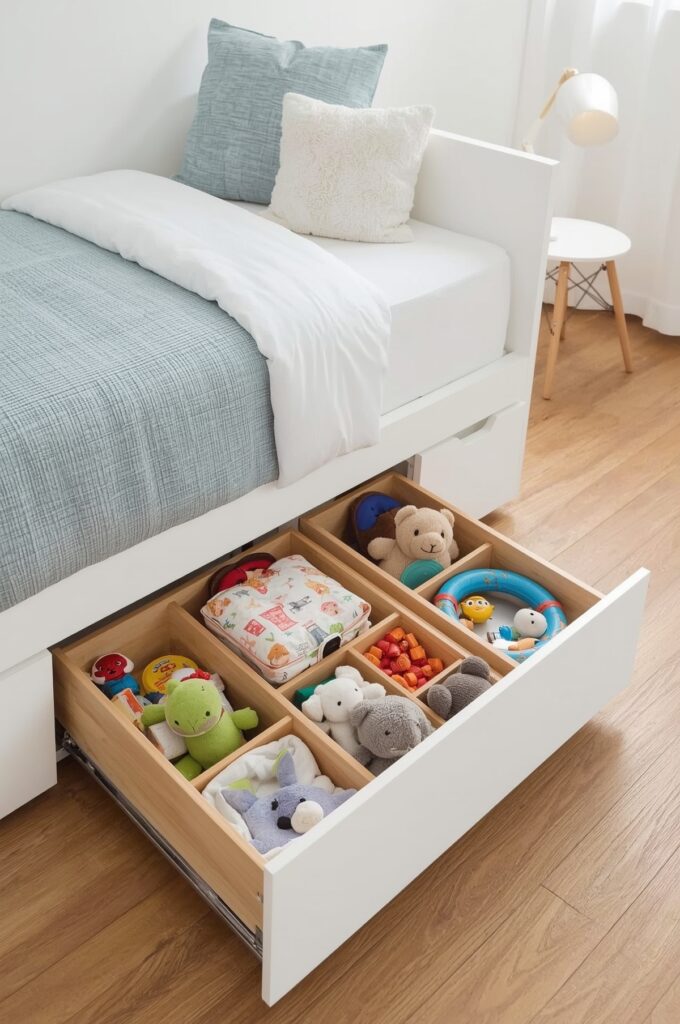
Maximize hidden space by adding pull-out drawers under beds. They are perfect for storing toys, games, or art supplies. The drawers keep items out of sight yet easy to access. This idea helps keep the floor clear, making the room look tidy and spacious.
49. Ceiling Hooks for Mini Swings
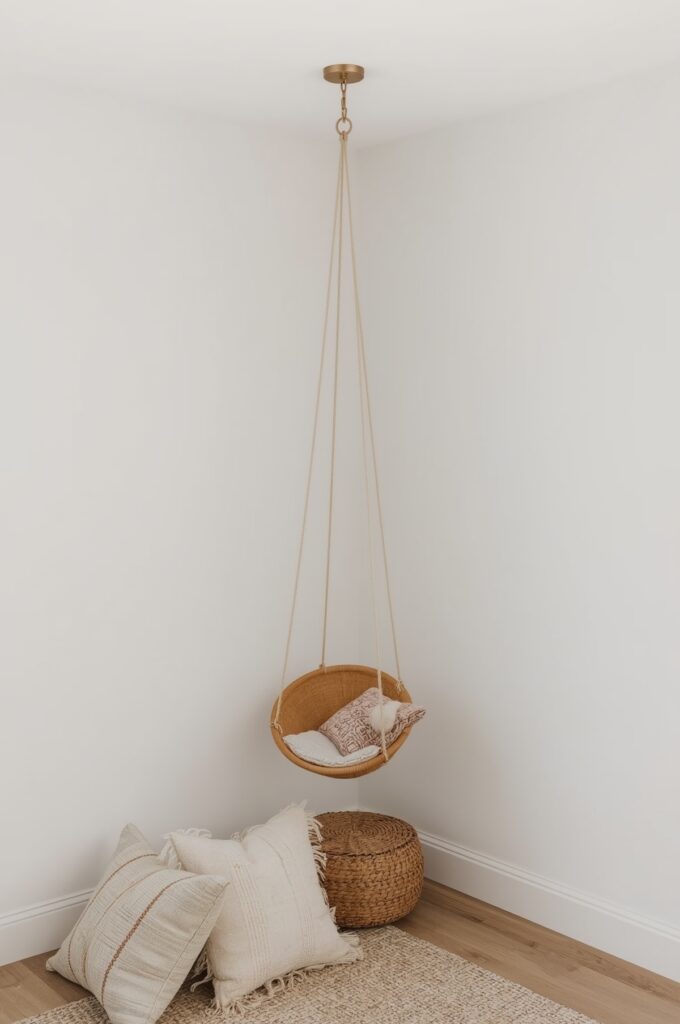
Install strong ceiling hooks to hang mini swings, hammocks, or hanging chairs. Swings add motion and fun, which kids love, while keeping the floor open. Choose removable options so the space can quickly transform back to free play when needed.
50. Lego-Compatible Wall Panels
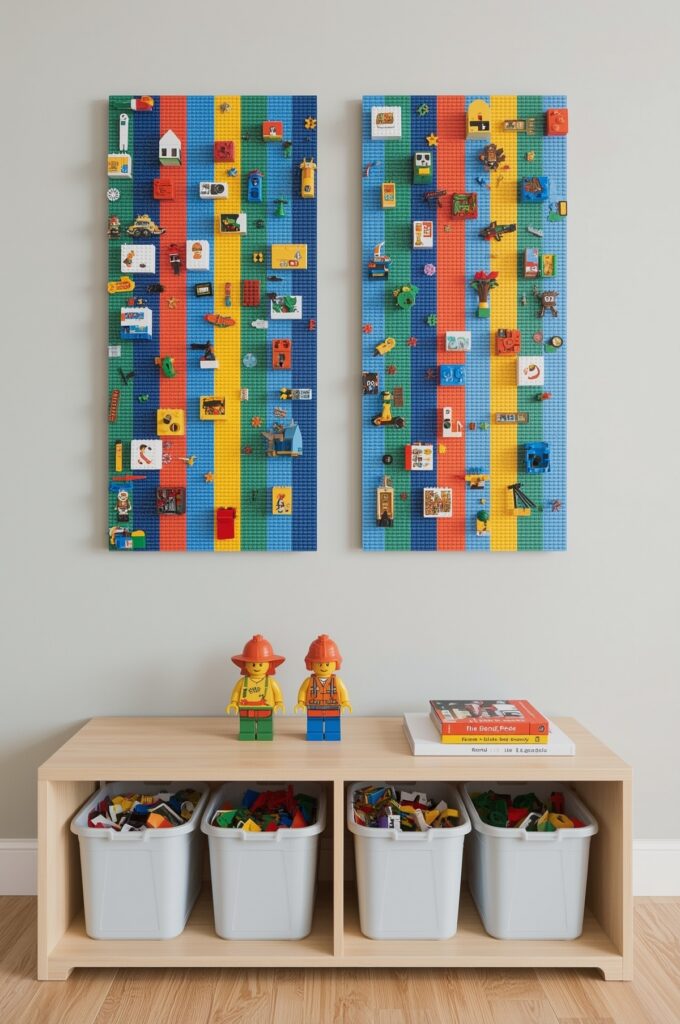
Turn a section of the wall into a Lego board by mounting Lego-compatible panels. Kids can build vertically, saving the floor from scattered bricks. It provides a dedicated building space that encourages creativity, keeps projects organized, and adds a fun interactive wall feature.
51. Stackable Modular Toy Cubes
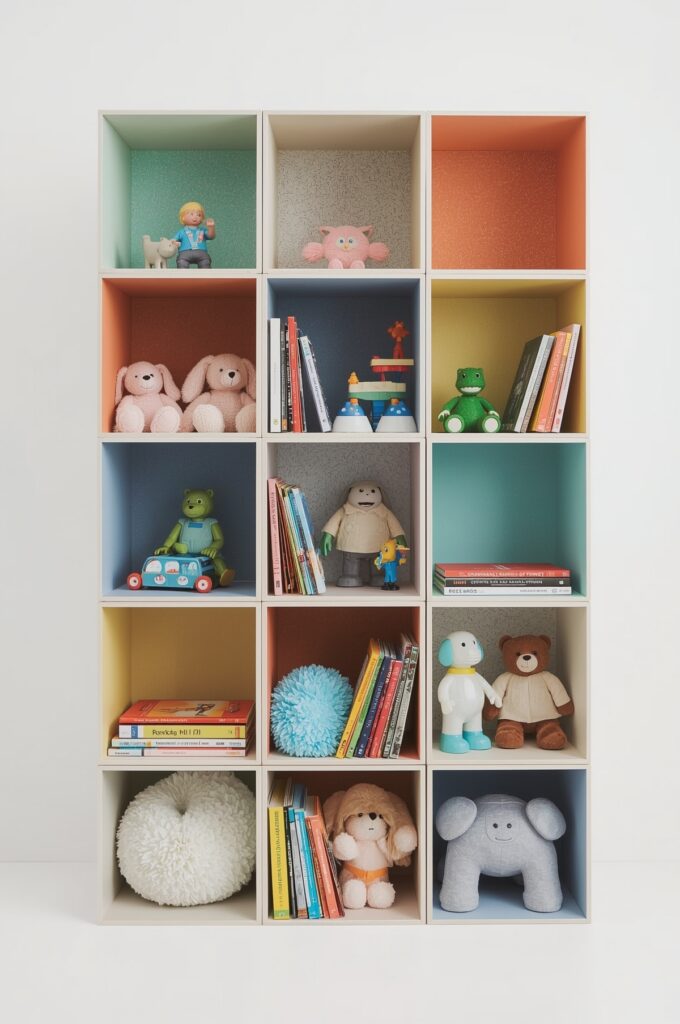
Use modular storage cubes that can be stacked and rearranged as needed. They adapt to the room’s size and can be expanded over time. Clear cubes make toys easy to see, while colorful ones add vibrancy. This flexible system grows as your child’s needs change.
52. Warm String Lights for Cozy Vibe
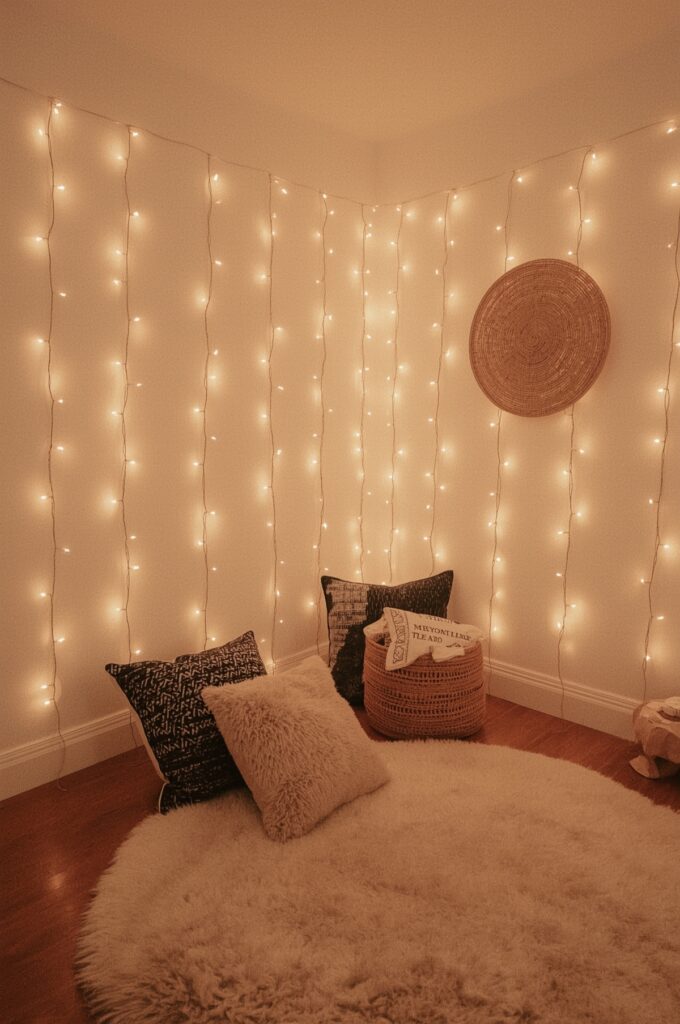
Add warm string lights to create a soft, magical glow in the playroom. They can highlight a reading nook, tent, or wall display. The gentle lighting makes the space inviting, calming, and safe, perfect for both play and winding down before bedtime.
53. Fold-Down Play Table Against the Wall
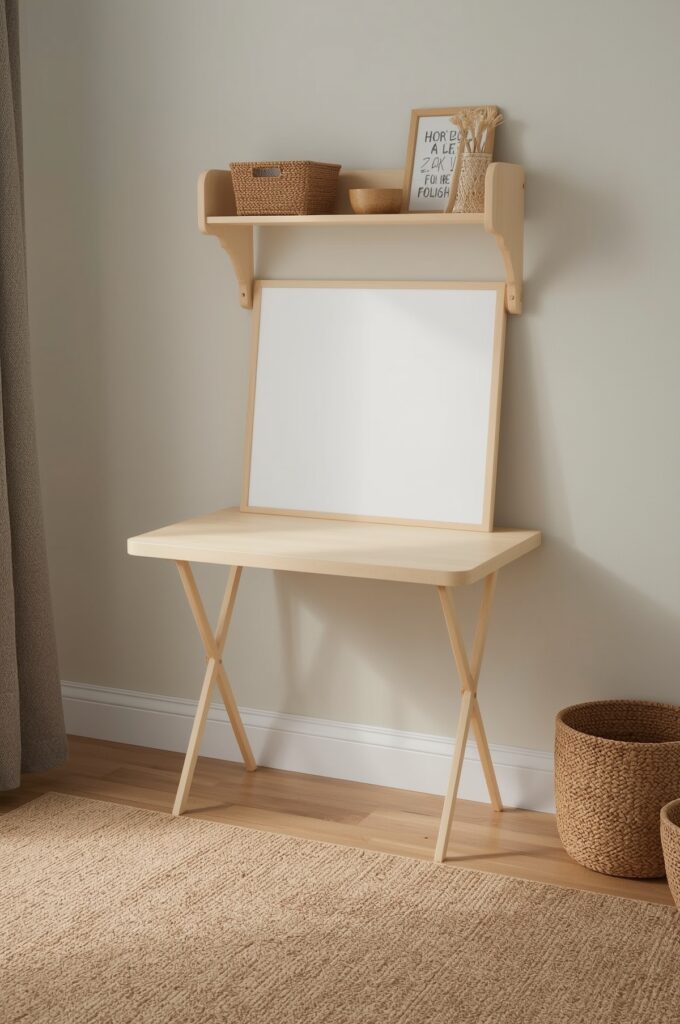
Install a fold-down table that stays flat against the wall when not in use. Kids can pull it out for crafts, puzzles, or games, then fold it back to free the floor. This practical and flexible idea works perfectly in tight play areas.
Final Takeaways
Small playrooms don’t have to feel cramped or cluttered. With the right design, they can be versatile, organized, and full of personality. By using smart storage, foldable furniture, and vertical space, you can give your kids a place to learn, create, and play freely. These 53 Small Space Playroom Ideas prove that big fun can happen in even the smallest of rooms. With a little planning and imagination, you can design a space that grows with your children and makes lasting memories.
- 49 Small Space Cloth Organization Ideas to Transform Your Closet and Home - December 2, 2025
- 45 Small Space Saving Bedroom Storage Ideas for a Stylish and Clutter-Free Home - December 1, 2025
- 31 Clever Small Space Hamper Ideas to Maximize Storage and Style - November 29, 2025

